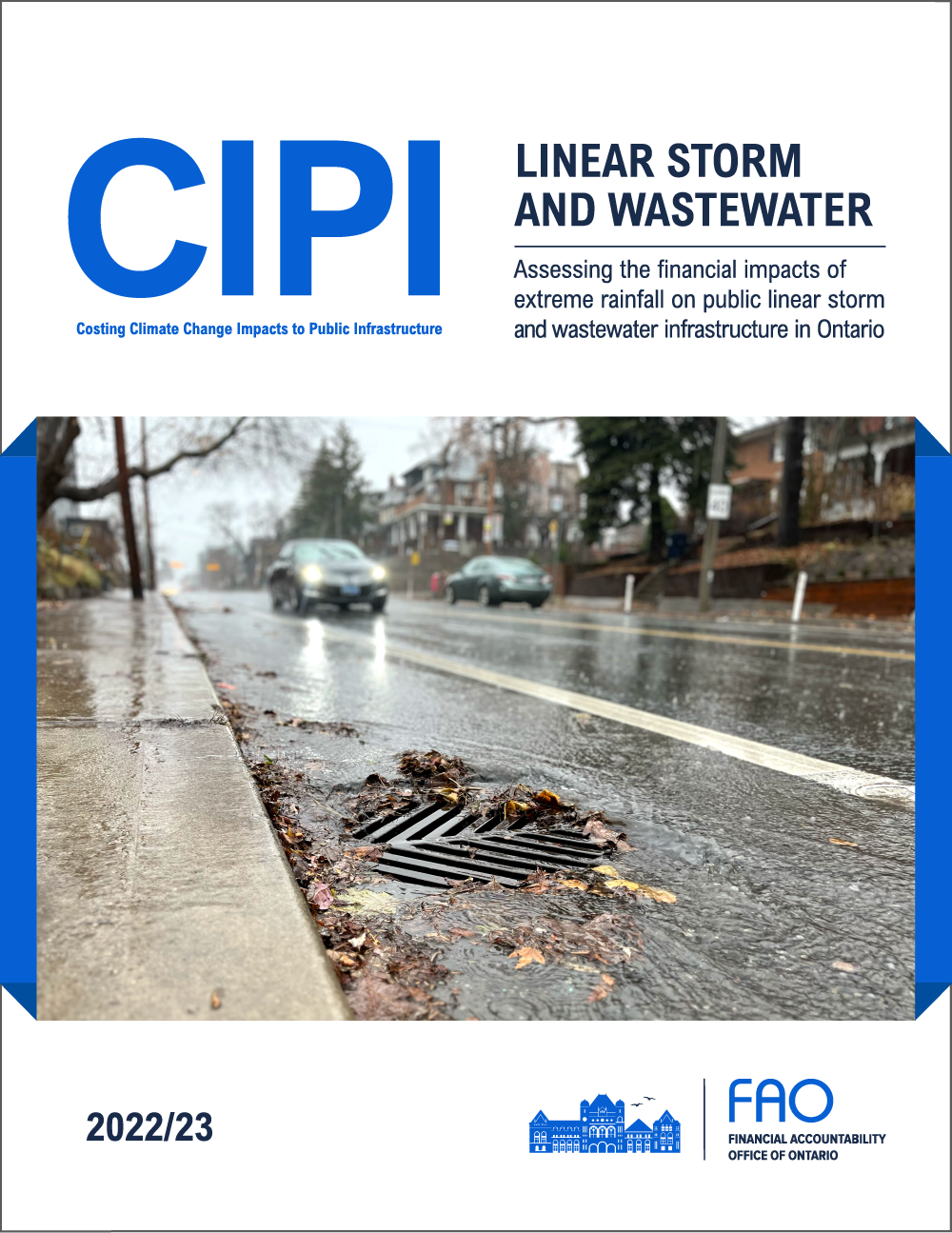For more information click here for the Costing Climate Change to Public Infrastructure portal.
Glossary of Terms
Table of Abbreviations
Term Definition
- CIPI
- Costing Climate Change Impacts to Public Infrastructure (project)
- CRV
- Current Replacement Value
- IDF
- Intensity-Duration-Frequency (Curve)
- IPCC
- Intergovernmental Panel on Climate Change
- O&M
- Operations and Maintenance
- RCP
- Representative Concentration Pathway
- SME
- Subject-Matter Expert
- USL
- Useful Service Life
- WSP
- WSP Global Inc.
Definitions
Current Replacement Value: The current cost of rebuilding an infrastructure asset with the equivalent capacity, functionality and performance.
Operations and Maintenance (O&M): The routine activities performed on an asset that maximize service life and minimize service disruptions without altering the physical components of the asset.
Rehabilitation: Repairing part or most of an asset to extend its service life, without adding to its capacity, functionality or performance.
Renewal: Replacement of an existing asset, resulting in a new or as-new asset with an equivalent capacity, functionality and performance as the original asset. Renewal is different from rehabilitation, as renewal rebuilds the entire asset.
State of Good Repair: A performance standard which helps to maximize the benefits of public infrastructure in a cost-effective manner over time and ensures that infrastructure operates in a condition that is considered acceptable from an engineering perspective.
Stable Climate: A stable climate scenario assumes that climate indicators for extreme rainfall remain unchanged from their 1975-2005 average levels over the projection to 2100.
Rest of the Century: Refers to the 79 years from 2022 to 2100.
Baseline Cost: The operations and maintenance, rehabilitation, and renewal expense that would have been required to maintain public storm and wastewater infrastructure in a state of good repair in a stable climate.
Acute Hazard: Severeclimate hazards that occur rarely (such as the 100-year storm event).
Chronic Hazard: Climate hazards that occur often, such as heaviest annual 5-day rain.
Adaptation: Adaptation is modelled as an alteration of an asset’s physical components or its surroundings to prevent increased O&M expenses and more rapid deterioration (when applicable) caused by changes in extreme rainfall. In addition, adaptation ensures adequate capacity, minimizing flood risk from more extreme rainfall. Adaptation can be done during an asset’s service life or at renewal.
No Adaptation Strategy: An asset management strategy where public infrastructure assets are not adapted to more extreme rainfall.
Reactive Adaptation Strategy: An asset management strategy where publicinfrastructure assets are only adapted at the time of renewal to withstand more extreme rainfall.
Proactive Adaptation Strategy: An asset management strategywhere a majority of public infrastructure assets are adapted to withstand more extreme rainfall during the asset’s service life.
1 | Introduction and context
In June 2019, a Member of Provincial Parliament asked the FAO to analyze the costs that the impacts of climate change could impose on Ontario’s provincial and municipal infrastructure, and how those costs could affect the long-term budget outlook of the province. In response, the FAO launched its Costing Climate Change Impacts to Public Infrastructure project (CIPI).
In the first phase of the project, the FAO assessed the composition and state of repair of provincial[1] and municipal[2] infrastructure, with findings released in November 2020 and August 2021.
In fall 2021, as part of the second phase of the project, the FAO released three reports: a project backgrounder[3] describing the overall context and methodology of the project, a report prepared by WSP Global describing the detailed engineering impact of climate hazards on public infrastructure,[4] and a report detailing how changes in extreme rainfall, extreme heat and freeze-thaw cycles will impact the long-term costs of maintaining Ontario’s public buildings and facilities in a state of good repair.[5] In September 2022, as part of the final phase, the FAO released a report detailing how changes in extreme rainfall, extreme heat and freeze-thaw cycles will impact the long-term costs of maintaining Ontario’s public transportation infrastructure in a state of good repair.[6]
This report examines the impacts of more extreme rainfall on the long-term costs of maintaining public linear storm and wastewater infrastructure in a state of good repair.
2 | Summary
Ontario’s municipalities manage a large portfolio of linear storm and wastewater infrastructure
This report examines public linear storm and wastewater infrastructure. Stormwater assets include pipes, ditches and culverts, while wastewater assets include sewer pipes and sanitary force mains. In total, these assets are valued at $124 billion (all costs are in 2020 real dollars) and are owned by Ontario’s 444 municipalities.
The cost to maintain the existing portfolio in a state of good repair is substantial, even in a stable climate
If the climate was stable, it would cost an average of $3.0 billion per year over the century to bring these assets into a state of good repair and maintain this state. These costs would accumulate to $240 billion by 2100.
More extreme rainfall is already increasing the costs of maintaining this portfolio
In the absence of adaptation, more extreme rainfall is expected to add a cumulative $6.2 billion to the costs of maintaining the portfolio of assets by 2030, a 27 per cent increase above the stable climate scenario.
In the absence of adaptation, more extreme rainfall will increase the costs of maintaining this portfolio throughout the century, but the extent of the increase will depend on global climate change
In a medium emissions scenario where global emissions peak by mid-century, more extreme rainfall would increase infrastructure costs by an average of $1.1 billion per year, totalling $88 billion in climate-related costs by 2100. This is a 37 per cent increase in costs relative to the stable climate scenario. In the high emissions scenario, where global emissions continue rising throughout the century, infrastructure costs would instead increase by $1.8 billion per year on average, totalling $145 billion by 2100 (a 61 per cent increase). These additional climate-related costs primarily arise from the higher operations and maintenance expenses required.
Proactively adapting linear storm and wastewater infrastructure to withstand more extreme rainfall will cost less than not adapting over the long term
Proactively adapting public storm and wastewater infrastructure, either by increasing its capacity or incorporating source control measures (such as green infrastructure), will add between $71 billion to $127 billion to infrastructure costs relative to the stable climate scenario by 2100. This represents a cost increase between 29 and 53 per cent. While significant, these additional climate-related costs are lower (in real dollars) than those incurred in the absence of adaptation or if adaptation was undertaken at a more gradual pace. This is due to the avoidance of higher climate-related operations and maintenance costs.
Adaptation also ensures that linearstorm and wastewater assets will have adequate capacity to manage more extreme rainfall, reducing flood risk
As extreme rainfall becomes more frequent and intense, unadapted assets will increasingly face capacity constraints, raising the flood risk to surrounding areas. While outside the scope of this report, the costs of flooding damages are likely to be substantial. In addition to being the least expensive strategy for municipalities (in real dollars), a proactive adaptation strategy would also most rapidly reduce flood risk.
Costing climate impacts to public infrastructure over the long term is subject to significant uncertainty
Climate-related infrastructure costs will depend on the future path of global emissions, the pace of adaptation, and the specific capacity of storm and wastewater infrastructure to convey more extreme rainfall. The FAO’s study presents median cost projections as well as a range of possible cost outcomes in each scenario that account for this uncertainty.
3 | Maintaining storm and wastewater infrastructure in a stable climate
This chapter presents the scope of municipal storm and wastewater infrastructure considered in this report, discusses the costs necessary to maintain these assets in a state of good repair, and estimates the long-term infrastructure costs required to maintain this portfolio to 2100 under a stable climate. The purpose of this chapter is to establish a baseline projection of infrastructure costs. In later chapters, this baseline is compared to projections that account for changes in extreme rainfall.
Ontario has a large portfolio of storm and wastewater infrastructure
Stormwater infrastructure is critical in reducing flood risk by managing the impact of sudden and heavy rainfall or the gradual melting of snow and ice. Wastewater infrastructure plays an important role in preventing water pollution and protecting public health by collecting, treating and discharging waste from domestic, commercial, industrial and agricultural activity.[7]
This report focuses on linear storm and wastewater infrastructure owned and controlled by Ontario’s municipal governments. Non-linear storm and wastewater assets, such as those related to treatment and disposal, are excluded from this report.[8] Drinking water infrastructure, which represents 14 per cent of municipal infrastructure,[9] is also excluded.[10]
The linear storm and wastewater assets considered in this report include stormwater pipes, ditches and culverts, as well as wastewater sanitary force mains and sewer pipes.[11] Throughout this report, these assets are referred to as “storm and wastewater infrastructure” or “storm and wastewater assets.” The following is a brief description of the various asset types:
- Stormwater pipes collect and convey stormwater (rain and melted snow) to areas where it is then disposed of, such as rivers, lakes or temporary holding ponds. These pipes are buried underground, often under existing infrastructure, such as roadways.
- Stormwater ditches are excavations in the ground made to capture, convey and remove stormwater. Ditches are mainly located on the sides of roads to drain stormwater from nearby road surfaces.
- Stormwater culverts are small non-structural culverts less than three metres in diameter. Culverts facilitate drainage between ditches, stormwater pipes and other drainage outlets. Culverts are typically found under driveways and roadways and are required when an entrance or road crosses a drainage ditch.
- Wastewater sewer pipes collect and convey wastewater to treatment facilities by gravity. These sewer pipes are buried underground, often under existing infrastructure, such as roadways. Many older municipalities have sewer systems that were built during or before the 1940s and include combined sewers that carry both wastewater and stormwater.
- Wastewater sanitary force mains are pressurized sewer pipes that transport wastewater from a lower to a higher elevation. These assets are buried underground, often under existing infrastructure, such as roadways.
The FAO estimates that the current replacement value[12] (CRV) of these storm and wastewater assets is $124 billion in 2022. Figure 3-1 presents the breakdown of this valuation by asset type. Stormwater assets account for 43 per cent of the CRV, while wastewater assets account for 57 per cent.
Figure 3-1 Ontario’s municipal portfolio of linear storm and wastewater infrastructure has an estimated Current Replacement Value of $124 billion

Note: CRV estimates are in real 2020 billion dollars. Percentage values refer to a sector’s share of total CRV.
Source: FAO.
Maintaining a large portfolio of public storm and wastewater infrastructure requires continual spending
Stormwater infrastructure is critical in reducing flood risks, while wastewater infrastructure plays an important role in preventing water pollution and protecting public health. To determine whether these critical services will be delivered, municipalities evaluate their infrastructure against level of service targets, one of which is keeping assets in a state of good repair.
Keeping assets in a state of good repair helps to maximize the benefits of public infrastructure in the most cost-effective manner over time. To be maintained in a state of good repair, assets require annual operations and maintenance (O&M) spending, as well as intermittent capital spending either to rehabilitate[13] an asset during its service life or renew[14] an asset at the end of its service life.
The costs to maintain public storm and wastewater infrastructure in a state of good repair reflect both the value of assets owned, as well as their condition, age and standards to which they must perform. For example, assets in poorer condition require more capital spending to bring them into a state of good repair. Likewise, older assets must be renewed sooner than newer assets.
To project the costs of maintaining public storm and wastewater infrastructure in a state of good repair, the FAO gathered and estimated asset-specific information on age, condition and current replacement value, as well as the general performance standards used to evaluate if an asset is in a state of good repair. Using an infrastructure deterioration model based on modelling techniques developed by the Ontario Ministry of Infrastructure,[15] the FAO projected the capital and operating expenses necessary to maintain the current portfolio[16] of public storm and wastewater infrastructure in a state of good repair to 2100, in the absence of climate considerations.[17]
These long-term O&M, rehabilitation and renewal spending estimates form the baseline projection against which the climate change costing scenarios will be compared. The baseline projection represents the infrastructure costs that would have been required to maintain public storm and wastewater infrastructure in a stable climate.[18] This allows the FAO to identify the additional climate-related infrastructure costs that are associated with changing climate hazards in later chapters.
Given the long useful service life of public storm and wastewater infrastructure, costs are projected to 2100. The results in this report are presented as average annual costs, as well as cumulative total costs over the century. Average annual costs are also presented over three time periods.
- The short term (2022-2030) shows how changing climate hazards are already impacting public infrastructure costs in the current decade.
- The mid-century (2031-2070) captures a period in which projections for the relevant climate variables begin to diverge in the three global emissions scenarios examined in this report.
- The late century (2071-2100) captures the period where projections for the relevant climate variables diverge significantly in the three global emissions scenarios.
All infrastructure cost projections presented in this report assume that the funding necessary to bring the current portfolio of storm and wastewater infrastructure into a state of good repair, and maintain this state, is made available and spent in a timely manner. In practice, infrastructure repair backlogs[19] exist and maintaining assets in a state of good repair is only one aspect of asset management.
The baseline cost projection does not include spending associated with assets currently under construction, planned for future construction or necessary to meet future infrastructure demand.[20]
$3 billion per year is needed to maintain the current portfolio of linear storm and wastewater infrastructure in a stable climate
The FAO projects that bringing Ontario’s existing suite of linear storm and wastewater infrastructure into a state of good repair and maintaining it until 2100 would have cost an average of $3.0 billion per year in a stable climate, which would accumulate to approximately $240 billion by the end of the century. This cumulative baseline cost includes $98 billion ($1.2 billion per year) in O&M expense and $142 billion ($1.8 billion per year) in rehabilitation and renewal expense to 2100.
Figure 3-2 The cumulative cost of maintaining Ontario’s linear storm and wastewater infrastructure in a state of good repair to 2100 in a stable climate

Note: All values presented in real 2020 dollars.
Source: FAO.
To maintain this portfolio in a stable climate, municipal governments would need to spend approximately $2.6 billion per year over the short term. Average annual costs remain similar in the mid-century period at $2.5 billion. By late century, average costs rise to $3.9 billion per year when a significant share of Ontario’s linear storm and wastewater infrastructure will have to be replaced.[21]
Figure 3-3 Maintaining Ontario’s public storm and wastewater infrastructure in a stable climate would have cost $3.0 billion per year
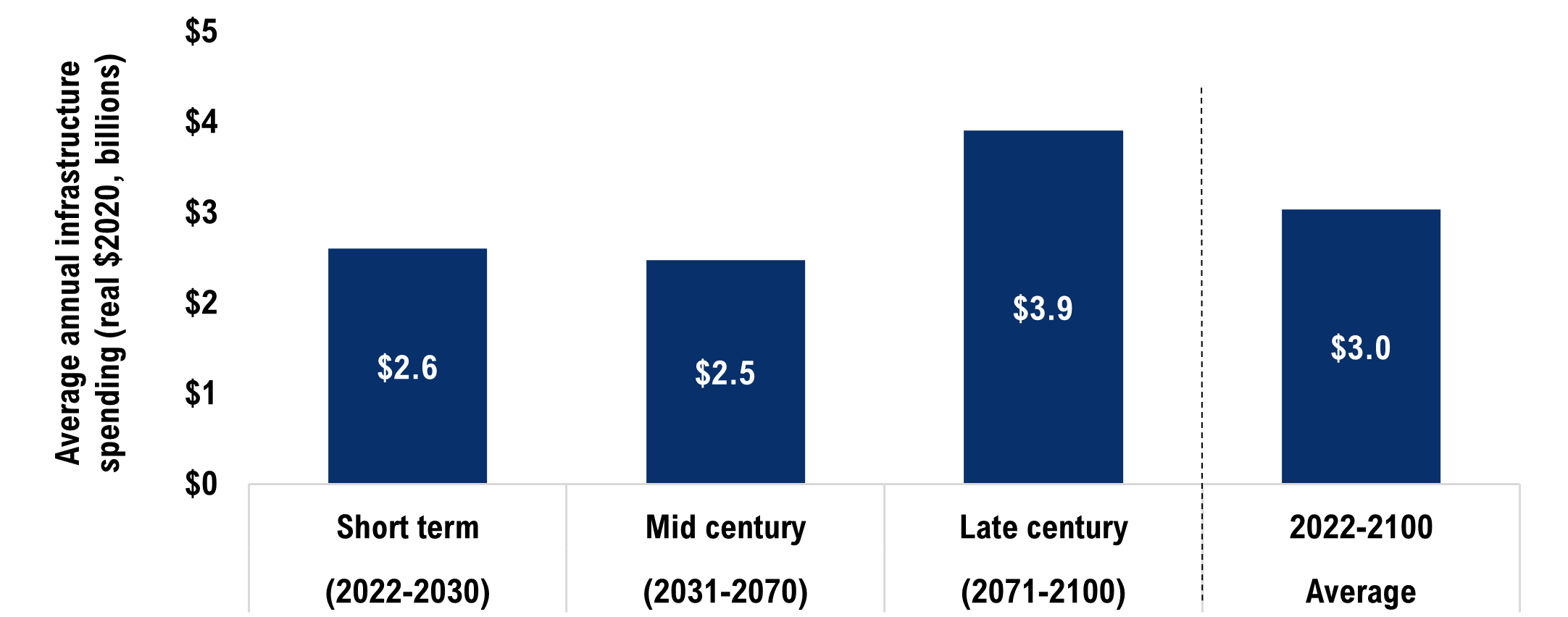
Source: FAO.
4 | The infrastructure costs of not adapting to more extreme rainfall
This chapter summarizes how projected changes in extreme rainfall would impact the costs of maintaining Ontario’s linear storm and wastewater infrastructure in the absence of adaptation measures. The first section provides an overview of how changes in extreme rainfall will impact the different asset types examined in this report. Next, the additional infrastructure costs of these impacts are estimated in the medium and high emissions scenarios. The chapter concludes with a discussion of how increases in extreme rainfall would challenge the capacity of these infrastructure systems, increasing the risk of flooding, and why these costs are excluded from the report.
Extreme rainfall is projected to increase
To ensure safety and reliability, infrastructure is designed, built and maintained to withstand a specific range of climate conditions typically based on historic climatic data.[22] However, many climate hazards are projected to increase in the future.
Climate change is associated with many hazards to public infrastructure, which can take the form of extreme weather events or long-term chronic impacts. Ontario has been subject to costly floods and ice storms and is also prone to droughts, intense rainfall, wildfires, windstorms, heatwaves and permafrost melt.[23] The broader CIPI project focused on only three climate hazards – extreme rainfall, extreme heat and freeze-thaw cycles – as they were determined to have broad and financially material impacts to public infrastructure and can be projected with a reasonable degree of scientific confidence.[24]
Unlike with buildings and transportation infrastructure, extreme heat or freeze-thaw cycles are not expected to significantly impact storm and wastewater infrastructure since many components are buried underground. However, extreme rainfall will have significant impact on storm and wastewater infrastructure as the frequency and intensity of storm events increase over the century.[25]
The impacts of extreme rainfall on Ontario’s public storm and wastewater infrastructure will depend on the path of global greenhouse gas emissions and the extent of global mean temperature increases. The FAO costed climate impacts to public storm and wastewater infrastructure for three global emissions scenarios:
- A low emissions scenario that assumes a major and immediate turnaround in global climate policies. Emissions are projected to peak in the early 2020s and decline to zero by the 2080s. By the end of the century, net emissions are negative. In this scenario, global mean temperatures are projected to increase by 1.6°C (0.8 to 2.4°C) by 2100 compared to the pre-industrial average (1850-1900).[26] The key results for this scenario are presented in Appendix E.
- A medium emissions scenario, where global emissions peak in the 2040s, then decline rapidly over the following four decades before stabilizing at the end of the century. In this scenario, the global mean temperature is projected to increase by 2.3°C (1.7 to 3.2°C) by 2100 relative to 1850-1900.
- A high emissions scenario that assumes global emissions continue to grow for most of the century.[27] Global mean temperatures are projected to increase by 4.2°C (3.2 to 5.4°C) relative to 1850-1900. Cumulative emissions from 2005 to 2020 most closely match the high emissions scenario.[28]
Uncertainty in climate change projections
The FAO partnered with the Canadian Centre for Climate Services at Environment and Climate Change Canada to acquire projections of key climate indicators for Ontario. To account for uncertainty in climate projections and in line with common practice in climate science, the median (50th percentile) projections of climate variables are presented, followed by ranges in parentheses. For Ontario climate indicators, the ranges indicate the 10th and 90th percentile projections from the ensemble of 24 climate models used by the Canadian Centre for Climate Services.
Figure 4-1 presents a brief description of the projected changes in some of the climate indicators used to represent extreme rainfall in this report. Appendix B contains a full description of all climate variables relevant to public storm and wastewater infrastructure, and their trends in all scenarios.
Figure 4-1 More extreme rainfall is projected for Ontario
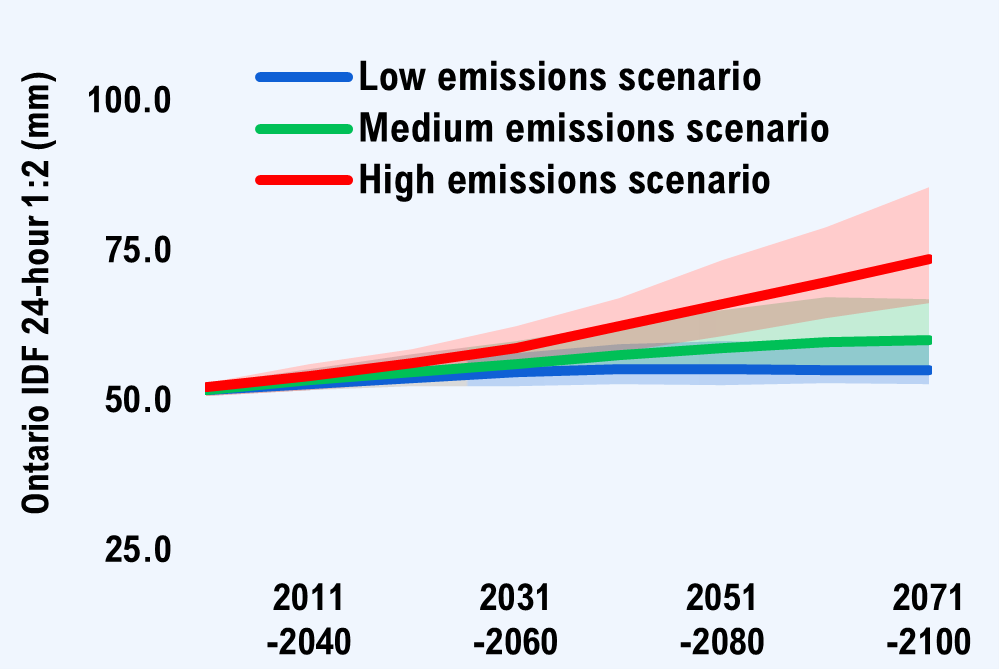
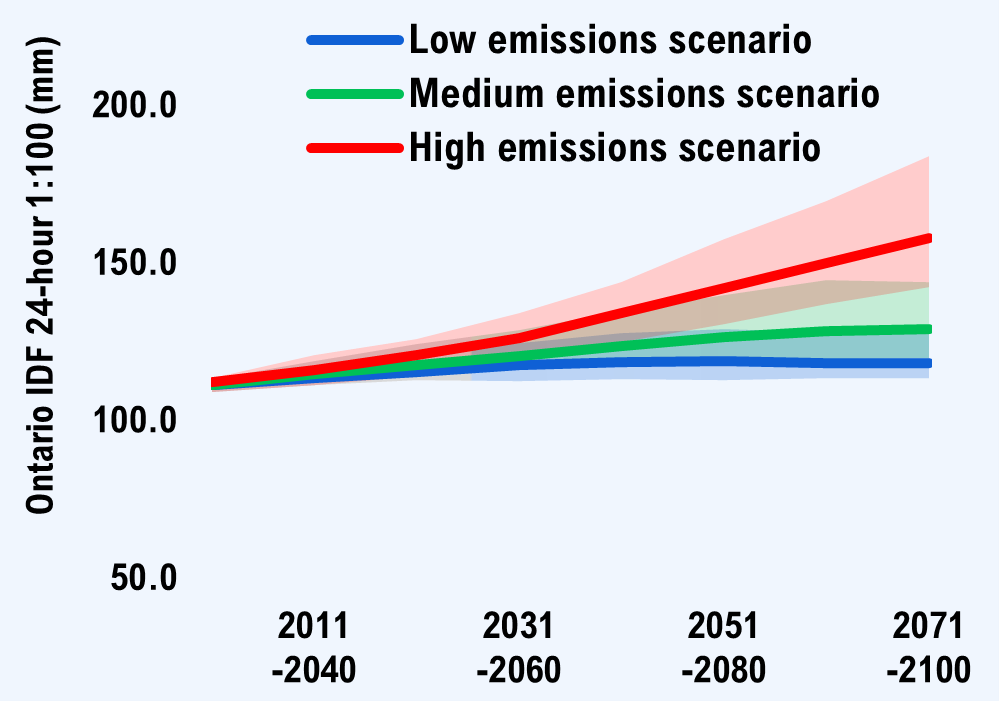
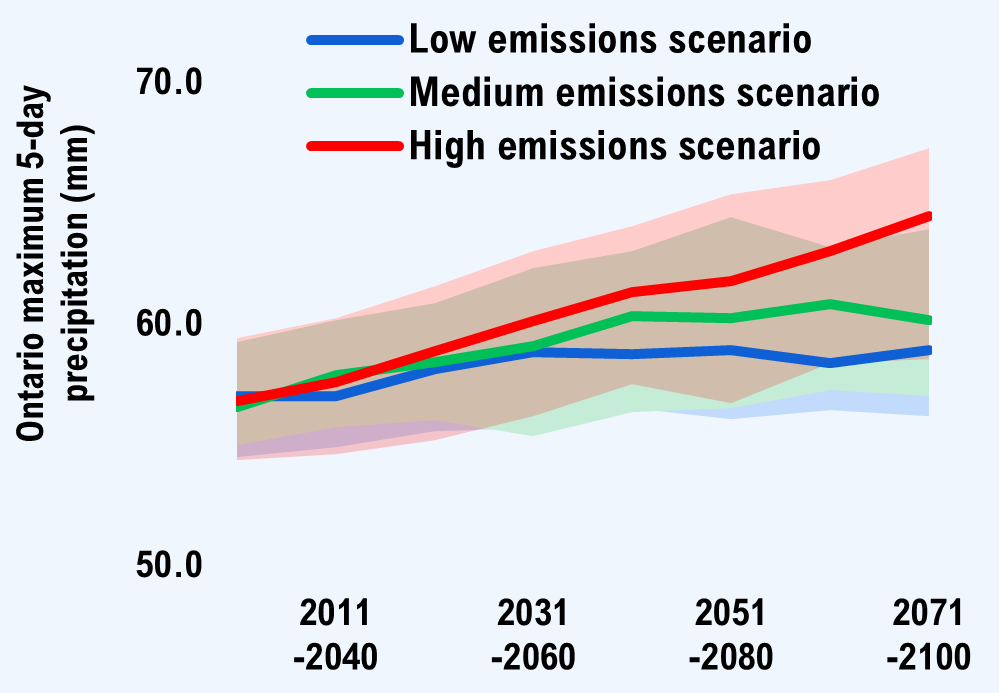
- Compared to the 1976-2005 baseline, the intensity of the 24-hour 1-in-2-year and 1-in-100-year rainfall events is projected to increase by 15 per cent (10 to 24 per cent) in the low emissions scenario and by 53 per cent (38 to 78 per cent) in the high emissions scenario by the 2071-2100 period.[29]
- Over the 1976-2005 period, a 1-in-2-year rainfall event averaged 48 mm of rain in 24 hours. By the 2071-2100 period, an average of 55 mm (53 to 59 mm) of rain is projected in the low emissions scenario and 73 mm (66 to 86 mm) of rain in the high emissions scenario.
- Over the 1976-2005 period, a 1-in-100-year rainfall event averaged 103 mm of rain in 24 hours. By the 2071-2100 period, an average of 118 mm (113 to 127 mm) of rain is projected in the low emissions scenario and 158 mm (142 to 184 mm) of rain in the high emissions scenario.
- There is medium confidence in the projected trends and ranges of aggregate precipitation variables based on how well climate models represent the climate processes involved.[30]
- Compared to the 1976-2005 baseline, the maximum amount of precipitation received during five consecutive days in a year is projected to increase by 9 per cent (8 to 12 per cent) in the low emissions scenario and by 19 per cent (13 to 20 per cent) in the high emissions scenario by the 2071-2100 period.
- Over the 1976-2005 period, the highest annual precipitation over five days averaged 54 mm. By the 2071-2100 period, an average of 59 mm (56 to 63 mm) is projected in the low emissions scenario and 64 mm (59 to 67 mm) in the high emissions scenario.
- Projections of maximum 5-day precipitation are associated with high-to-medium confidence. All model projections point to a positive trend in these variables, but the climate processes involved are more uncertain than for temperature variables.
Source: Canadian Centre for Climate Services.
More extreme rainfall will impact storm and wastewater infrastructure
The following section outlines the key engineering impacts of increases in both acute and chronic extreme rainfall on linear storm and wastewater infrastructure, and how these impacts will influence the costs of maintaining these assets.[31] The impacts of flooding to surrounding areas due to undersized storm and wastewater infrastructure, while out of scope for this project, are discussed at the end of the chapter.
Stormwater
Pipes
Stormwater pipes are usually designed to address more frequent rainfall events (i.e., 2-year storm events). As the intensity of extreme rainfall events increases, pipes will require more frequent and costly inspections and preventive maintenance, as more debris, sediment and vegetation are expected to enter stormwater systems.
Ditches
Ditches are generally constructed with higher capacity than pipes but are vulnerable to large overflow events. In urban areas, major systems must be able to convey the flow resulting from acute rainfall events such as the 100-year storm. As the intensity of extreme rainfall events increases, ditches will require more frequent clearing of debris, shape and slope maintenance, and vegetation pruning to convey increased amounts of stormwater.
Small Non-Structural Culverts
Small culverts are also vulnerable to overflow events. As the intensity of extreme rainfall events increases, these assets will require more frequent clearing of debris and sediments resulting from increased water flow. Channel protection will also be subject to accelerated erosion.
Wastewater
Sewer Pipes
Sewer pipes allow wastewater to flow by gravity from source to treatment facility. These assets are vulnerable to both short duration and long duration rainfall events. Increased intensity of short duration rainfall events will increase the inflow of surface water into sewer pipes, while increased intensity of longer duration events will cause groundwater to infiltrate sewer pipes. Due to increased inflow and infiltration, pipes will require more frequent inspections, maintenance and clearing of debris. These impacts are likely to be more severe for older and combined sewer systems.
Sanitary Force Mains
In areas where wastewater cannot be conveyed through a gravity-reliant system, sanitary force mains force wastewater up to higher elevations using a pressurized system. More extreme rainfall will result in higher inflow and infiltration, increasing the volume of wastewater being conveyed to treatment facilities, as well as the pressure required to do so. The increased need for pumping results in greater friction and stress on joints, as well as corrosion, accelerating the deterioration of these assets.
Figure 4-2 Examples of how more extreme rainfall will impact linear storm and wastewater infrastructure

Note: For more examples of how these climate hazards impact water infrastructure, see CIPI: WSP Engineering Report, 2021.
Source: WSP.
More extreme rainfall is raising the cost of maintaining public storm and wastewater infrastructure
In this section, the FAO presents the cost projections of a no adaptation asset management strategy. In this strategy, asset managers do not adapt public storm and wastewater infrastructure to withstand changing climate hazards, but instead pay higher costs to maintain their assets in a state of good repair in the face of increasing extreme rainfall. While in practice many climate change adaptation initiatives are under way (see Chapter 5), the intent of the no adaptation strategy is to explore the cost implications of not adapting public storm and wastewater infrastructure to extreme rainfall.
In the absence of adaptation actions, increasing extreme rainfall will shorten the useful service life (USL) of some public storm and wastewater infrastructure, requiring more frequent and additional rehabilitations relative to the stable climate scenario. More extreme rainfall will also result in higher spending on operations and maintenance (O&M). Taken together, these factors will increase the costs of maintaining the current portfolio of public storm and wastewater infrastructure in a state of good repair.
As extreme rainfall increases throughout the century, the existing capacity of storm and wastewater infrastructure will not be adequate, increasing flood risk to surrounding areas. The cost estimates presented below do not include the costs of flooding that could result from inadequate capacity (capacity issues are discussed at the end of this chapter).
Projecting public storm and wastewater infrastructure costs in the no adaptation strategy
Figure 4-3 shows the costs to maintain infrastructure in the no adaptation strategy. In the medium emissions scenario (median projection), more extreme rainfall will raise the average annual cost of maintaining the existing portfolio of public storm and wastewater infrastructure in a state of good repair by $1.1 billion per year over the century. This represents a 37 per cent increase in costs over what would have occurred in a stable climate. These average annual costs rise from $0.6 billion per year this decade, to $1.0 billion in the mid-century period, and $1.4 billion in the late century as rainfall becomes more extreme.
Figure 4-3 Changing climate hazards will raise the cost of maintaining the current portfolio of public storm and wastewater infrastructure in the absence of adaptation

Note: Uncertainty ranges are omitted from this chart for presentation purposes.
Source: FAO.
In the high emissions scenario (median projection), more extreme rainfall would instead raise average annual infrastructure costs by $1.8 billion per year over the century, a 61 per cent increase in costs relative to the stable climate scenario. In this case, climate-related costs increase from $0.7 billion this decade, to an average of $1.4 billion in the mid-century period, rising to $2.8 billion by late century.
The larger costs in the high emissions scenario occur because rainfall is projected to become more extreme throughout the century. In contrast, the pace of change in extreme rainfall slows by mid-century in the medium emissions scenario (see Figure 4-1).
Figure 4-4 Uncertainty ranges around annual climate-related costs widen over time
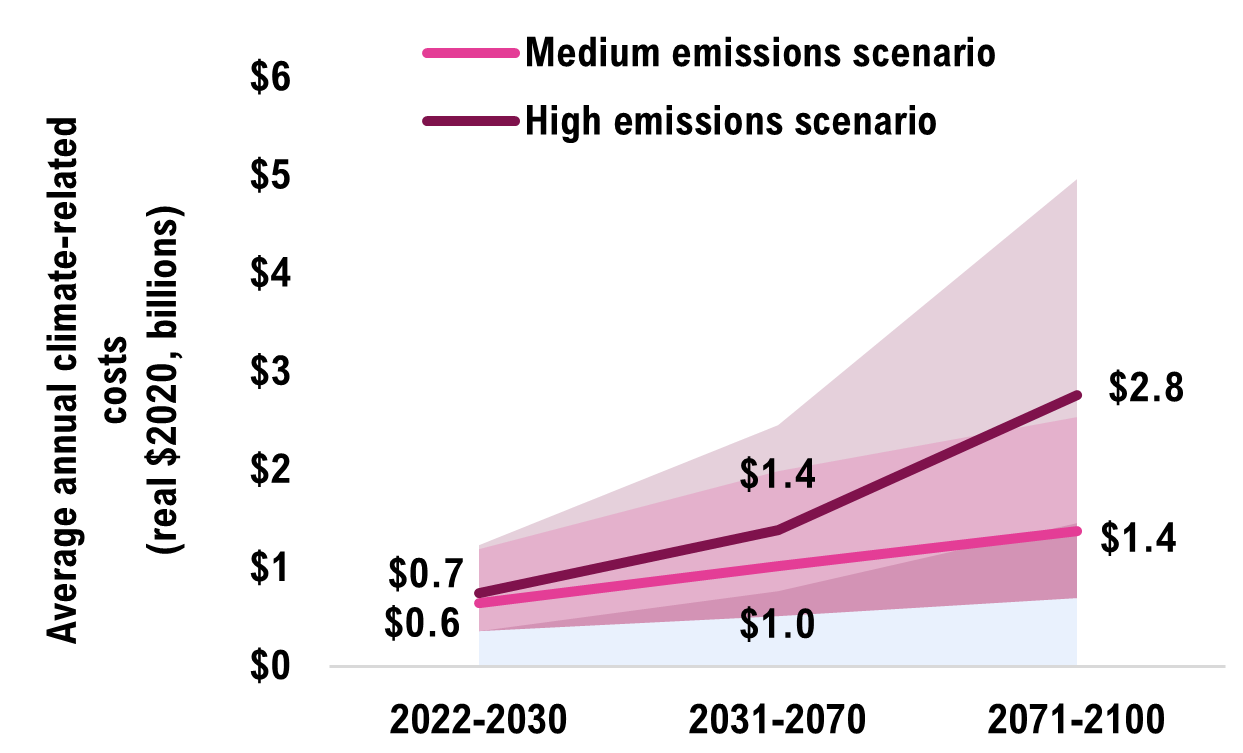
Note: The solid line is the median (or 50th percentile) projection. The coloured bands represent the range of possible outcomes in each emissions scenario.
Source: FAO.
There is uncertainty in the extent of warming that will occur in each emissions scenario (see Figure 4-1), as well as engineering uncertainty in how more extreme rainfall will impact Ontario’s storm and wastewater infrastructure (see Appendix C). The full range of average annual climate-related costs is presented in Figure 4-4.
These average annual costs would accumulate over the projection. In the short term (2022-2030), annual climate-related costs from more extreme rainfall average $0.7 billion across the medium and high emissions scenarios, which would accumulate to approximately $6.2 billion by 2030 in the absence of adaptation.[32] This is a 27 per cent increase in municipal infrastructure costs relative to the stable climate projection.
Figure 4-5 In the absence of adaptation, climate-related costs accumulate to significant sums by 2100
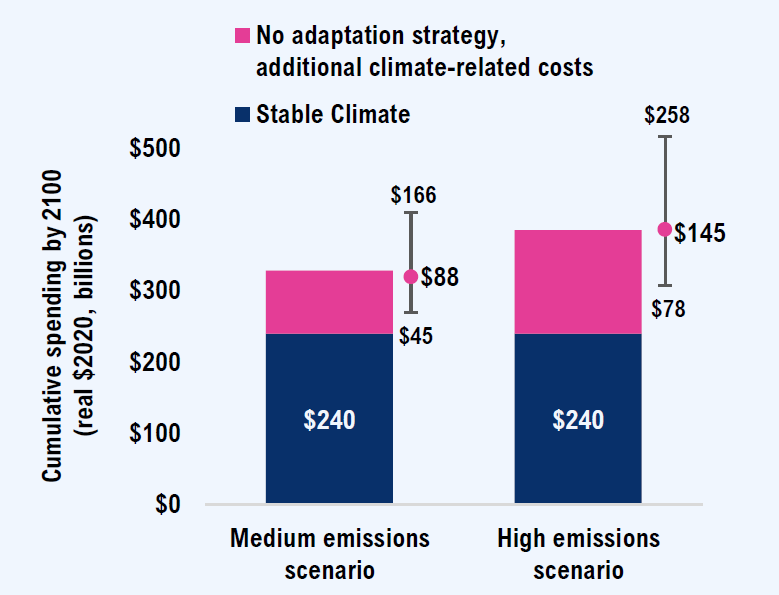
Source: FAO.
Figure 4-5 presents the cumulative spending required to maintain infrastructure over the projection. In the medium emissions scenario (median projection), the cumulative cost of maintaining the existing portfolio of public storm and wastewater infrastructure in a state of good repair will increase by $88 billion over the century.This represents a 37 per cent increase in costs over what would have occurred in a stable climate. These cumulative costs could range from $45 billion to $166 billion given the climate and engineering uncertainties.
In the high emissions scenario (median projection), the cumulative cost would instead increase by $145 billion (a 61 per cent increase), with a range of $78 billion to $258 billion.
More extreme rainfall is also increasing the risk of flooding
Many municipalities assess flood risk by determining if their infrastructure has sufficient (or excess) capacity to accommodate major storm events,[33] based on municipal design guidelines that often rely on historical storm events. However, future rainfall intensities are expected to surpass design standards in some cases, which could lead to more frequent flooding events. These flooding events would occur even if the storm and wastewater systems remain in a state of good repair because future extreme rainfall could exceed existing design capacities.
For example, the City of Toronto’s ditches and underground storm water systems are designed to accommodate runoff from 2-year storm events with an estimated 24-hour intensity of 44 mm.[34] Projections from the Canadian Centre for Climate Services for extreme rainfall in the Toronto region indicate that this figure could rise to 51 mm (49 to 53 mm) over the 2021-2050 period in the low emissions scenario, and up to 67 mm (61 to 75 mm) over the 2071-2100 period in the high emissions scenario.
All asset types examined in this report will be vulnerable to capacity issues as extreme rainfall increases over time, increasing flood risk to surrounding areas.[35] In the past, flooding events have caused extensive property damage.
- In 2013, flash flooding in Toronto resulted in $940 million in damages.[36]
- In 2018, a thunderstorm in Toronto that produced 51 mm of rain in one hour resulted in over $80 million in insured damages.[37]
- Extreme rainfall in the Windsor region in both 2016 and 2017 led to significant flooding, resulting in $232 million of insured damages.[38]
While these events have not been directly linked to climate change, they demonstrate how flooding events can cause significant property damage to Ontario households and businesses.
Flooding can also result in water pollution as floodwaters mix with agricultural waste, chemicals or raw sewage and contaminate drinking water as well as cause other public health concerns.[39]
The CIPI project focuses on estimating how changing climate hazards will impact the cost of maintaining existing linear storm and wastewater infrastructure in a state of good repair. This scope does not include the costs of flooding to households or businesses when this infrastructure fails to adequately convey stormwater. However, these costs are likely to be significant and as such, are an area for further research that could greatly benefit the public interest.
Figure 4-6 Insufficient capacity of storm and wastewater infrastructure can result in flooding and property damage
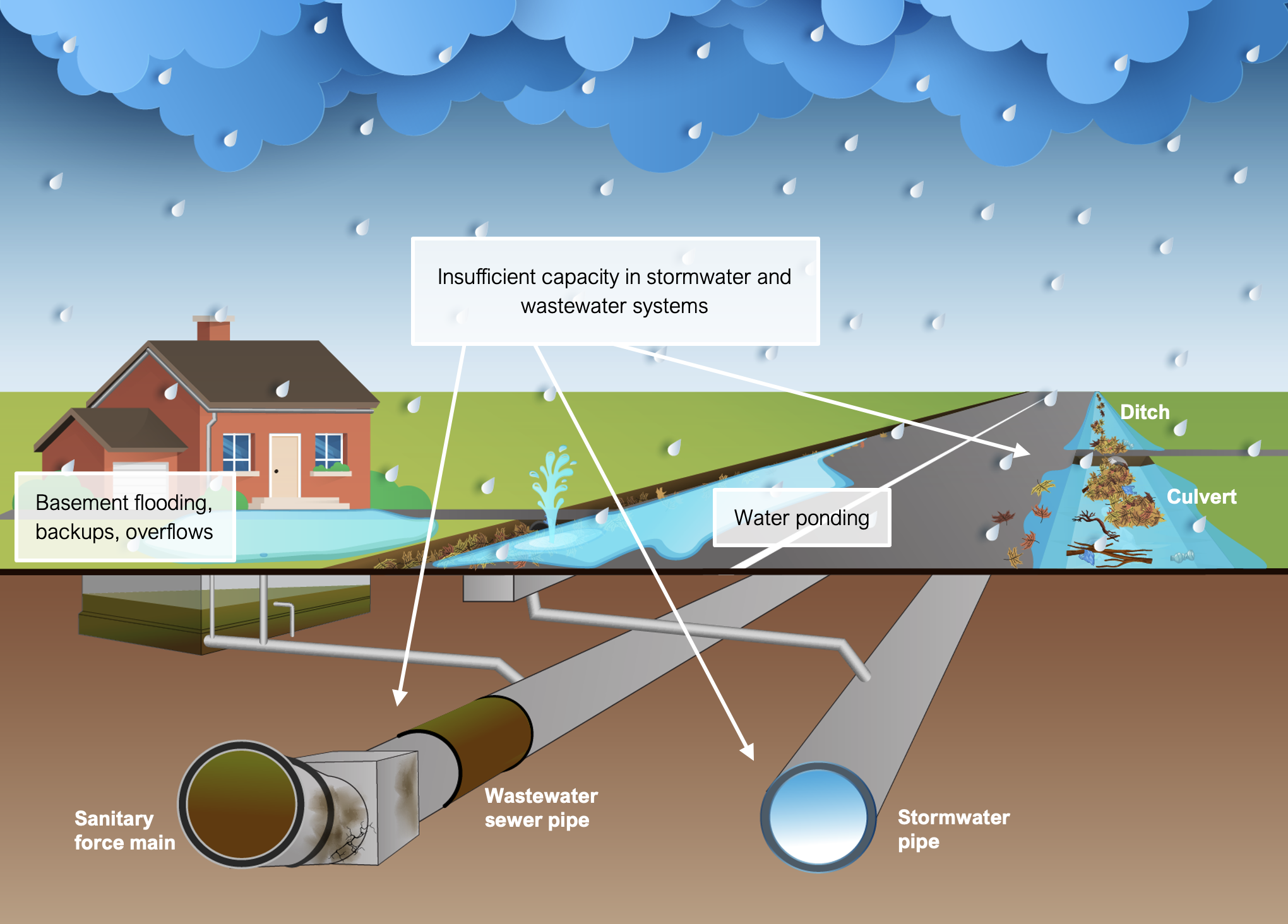
Source: FAO.
5 | The costs of adapting linear storm and wastewater infrastructure
Chapter 4 projected how more extreme rainfall would impact the costs of maintaining Ontario’s storm and wastewater infrastructure in the absence of adaptation measures. The chapter also described how inadequate capacity of storm and wastewater infrastructure can impair its ability to convey water, causing more frequent flooding. In practice, storm and wastewater infrastructure can be adapted to withstand these impacts and avoid accelerated deterioration and higher O&M expenses from more extreme rainfall. Adaptation can also ensure that these assets will have adequate capacity to manage increasing extreme rainfall, reducing flood risk to surrounding areas.
This chapter defines the scope of adaptation analyzed in this report and estimates a range of costs to adapt Ontario’s portfolio of public storm and wastewater infrastructure to withstand late-century climate projections for extreme rainfall in the medium and high emissions scenarios.
Adapting public storm and wastewater infrastructure can help prevent the impacts of more extreme rainfall
Figure 5-1 Ontario’s linear storm and wastewater infrastructure assets have long remaining useful service lives

Source: FAO.
Ontario’s linear storm and wastewater infrastructure assets have long useful lives, as shown in Figure 5-1. Of the $124 billion in infrastructure, 13 per cent has a remaining useful life of 0-40 years, while 87 per cent of assets have a remaining useful life of 40-80 years. Given the long useful lives of public storm and wastewater infrastructure, late-century climate conditions are relevant to adaptation decisions being made now, which will impact public infrastructure costs throughout the century.
However, climate projections depend on the trajectory of global emissions, which remains uncertain. This raises the challenge of how projected changes in key climate hazards should be accounted for when linear storm and wastewater infrastructure is designed, built or rehabilitated.[40]
Adapting linear storm and wastewater infrastructure to withstand more extreme rainfall could take many forms. A few examples include:
- addressing gaps in standards and best practices for stormwater and wastewater management, such as defining and incorporating a consistent level of service across provincial and municipal design guidelines;[41]
- changing the way assets are managed, for example, altering the frequency of operations and maintenance schedules or improving the monitoring and maintenance of drainage systems;[42]
- managing stormwater in urban areas through low-impact development, such as the use of permeable pavement and green infrastructure, which helps to soak rainwater into the ground and reduce the runoff volume managed through conventional stormwater systems;[43]
- planting urban forests that help retain stormwater;[44]
- enabling municipalities to plan and implement robust systems for surface drainage of settlement areas;[45]
- separating drainage and sanitary systems to reduce the flow of stormwater into wastewater systems;[46] and
- improving flood plain mapping of areas at risk of flooding that could support the development of flood control bylaws.[47]
Figure 5-2 presents some examples of adaptation measures for storm and wastewater infrastructure components included in the FAO’s modelling framework. These adaptations would prevent accelerated deterioration and higher O&M costs caused by more extreme rainfall, as well as increase the capacity of this infrastructure and reduce flood risk.[48]
Figure 5-2 Examples of adaptations to extreme rainfall for linear storm and wastewater infrastructure

Note: For more examples of how linear storm and wastewater infrastructure components can be adapted to climate hazards, see CIPI: WSP Engineering Report, 2021.
Source: WSP.
Adaptation strategy costs vary based on the approach taken
To estimate adaptation costs, the FAO assumed that public storm and wastewater infrastructure assets are adapted to accommodate late-century projections[49] for extreme rainfall. Once adapted, the FAO assumes that the asset no longer faces additional O&M and capital expenses due to more extreme rainfall. Adaptation also ensures storm and wastewater assets will have adequate capacity to manage more extreme rainfall, reducing flood risk in surrounding areas.
The additional infrastructure costs of an adaptation strategy include higher capital expenses from increased deterioration and higher O&M expenses until adaptation (but no costs associated with flooding in surrounding areas), and a one-time adaptation expense. After an asset is adapted, it no longer experiences accelerated deterioration and higher O&M costs due to more extreme rainfall. The costs presented in this chapter would occur instead of those estimated in the no adaptation strategy presented in Chapter 4.
The costs of an adaptation strategy would vary based on when the adaptation actions are undertaken. To highlight how these costs could vary, the FAO developed two adaptation strategies.
- Reactive adaptation strategy: Storm and wastewater assets are only adapted at the time of renewal. This approach results in a gradual increase in the share of adapted assets over the century, with only about 10 per cent of assets adapted by 2050 and 43 per cent adapted by 2070. By 2100, all assets are adapted.
- Proactive adaptation strategy: Storm and wastewater assets are adapted at the first available opportunity. This occurs either during an asset’s next major rehabilitation (where instead of rehabilitating the asset, it is replaced with a new adapted asset) or at renewal, whichever comes first. In this approach, 33 per cent of storm and wastewater assets are adapted by 2030 and all assets are adapted by 2070.
Figure 5-3 The proactive adaptation strategy has a faster pace of adaptation over the century
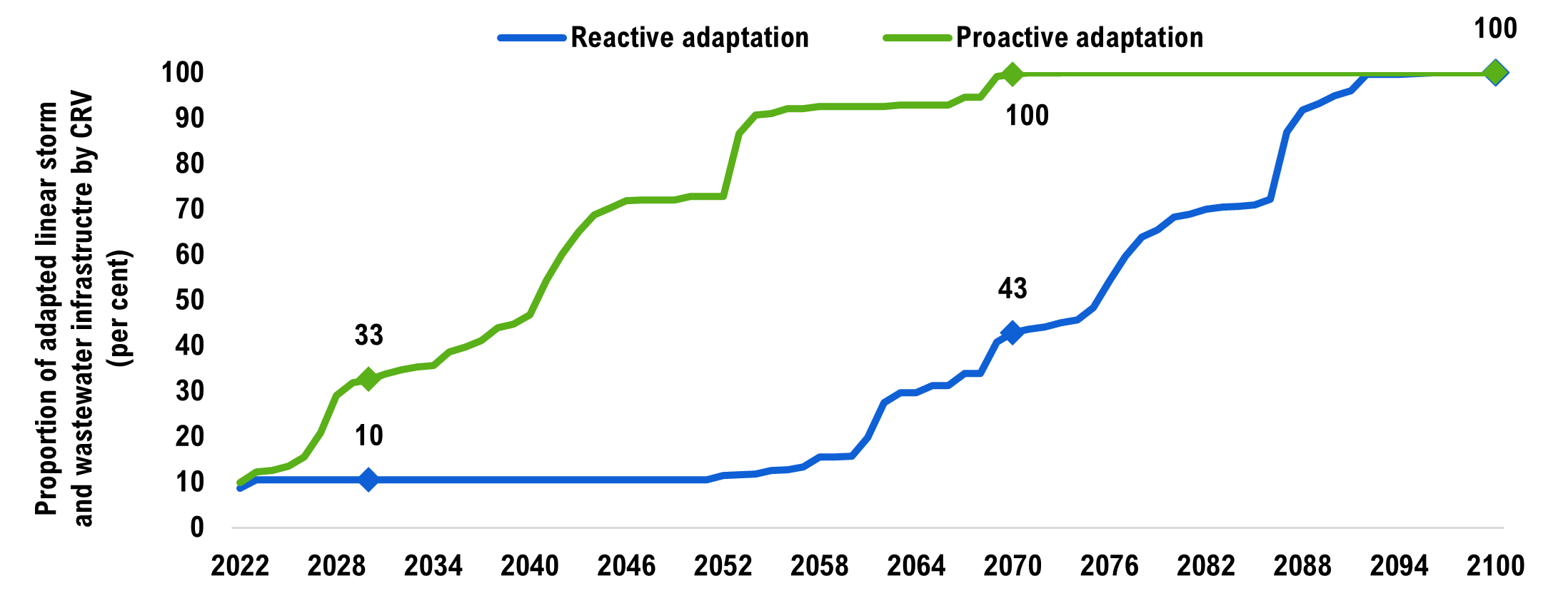
Note: The results presented are based on the average results for the median (or 50th percentile) projection in the medium and high emissions scenarios. Uncertainty bands are omitted from this figure for presentation purpose.
Source: FAO.
The pace of adaptation of storm and wastewater infrastructure in the two strategies will also impact flood risk in surrounding areas. The gradual pace of adaptation in the reactive adaptation strategy means that a large proportion of infrastructure will remain unadapted for a longer period, with only 43 per cent of assets adapted by 2070, leaving a significant exposure to flood risk.
In contrast, the faster pace of adaptation in the proactive adaptation strategy lowers flood risk more rapidly as a larger share of the assets in the portfolio are adapted much sooner. By 2030, one-third of the portfolio is adapted to late-century projections of extreme rainfall, while by 2050 that share rises to over 70 per cent. By 2070, the entire portfolio is adapted to the impacts of more extreme rainfall. While adapting the entire portfolio of storm and wastewater infrastructure will not eliminate flood risk entirely, rapid adaptation will lower flood risk sooner than in the reactive strategy.
Projecting public storm and wastewater infrastructure costs in the reactive adaptation strategy
In the reactive adaptation strategy, storm and wastewater assets are adapted at the time of renewal, resulting in a gradual pace of adaptation that leaves flood risks largely unaddressed throughout most of the century (see Figure 5-3).
Figure 5-4 shows the average annual climate-related costs in the reactive adaptation strategy. In the medium emissions scenario (median projection), average annual infrastructure costs would increase by $1.1 billion per year over the century. This represents a 37 per cent increase in costs over what would have occurred in a stable climate. These average annual costs rise from $0.9 billion per year this decade, to $1.1 billion in the mid-century period, and to $1.2 billion per year in the late century as the pace of adaptation increases.
In the high emissions scenario (median projection), average annual infrastructure costs would instead increase by $1.9 billion per year over the century, a 62 per cent increase in costs relative to the stable climate scenario. In this scenario, climate-related costs increase from $1.3 billion this decade, to an average of $1.7 billion in the mid-century period, then increasing to $2.3 billion in the late century.
Costs in the high emissions scenario are larger than in the medium emissions scenario as more extreme rainfall accelerates deterioration and raises the O&M costs of non-adapted assets. Adaptation costs are also higher relative to the medium emissions scenario due to the higher design standards required to withstand the high emissions scenario.
Figure 5-4 Adaptation will raise storm and wastewater infrastructure costs, but more so in the high emissions scenario
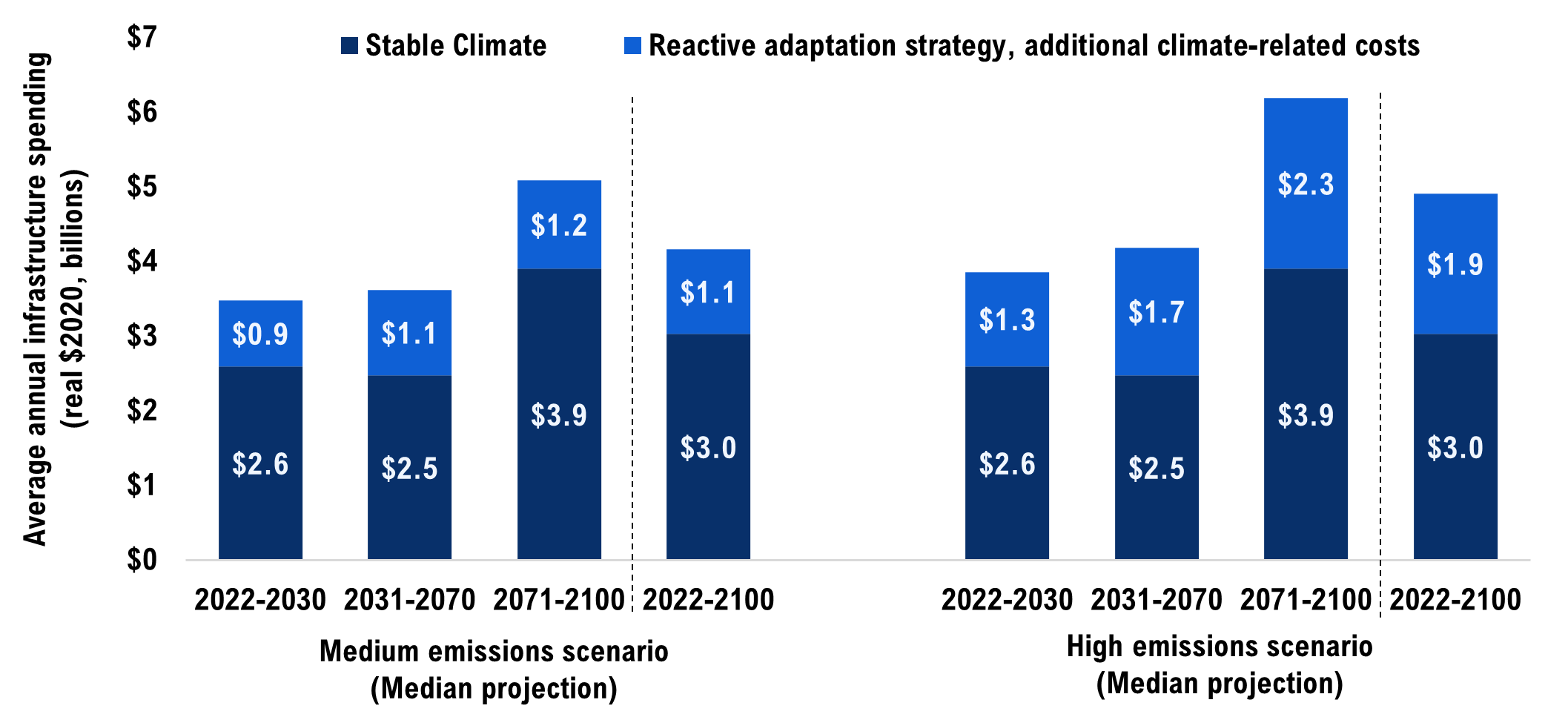
Note: Uncertainty ranges are omitted from this chart for presentation purposes.
Source: FAO.
Figure 5-5 Climate-related costs in the reactive adaptation strategy are subject to climate and engineering uncertainty
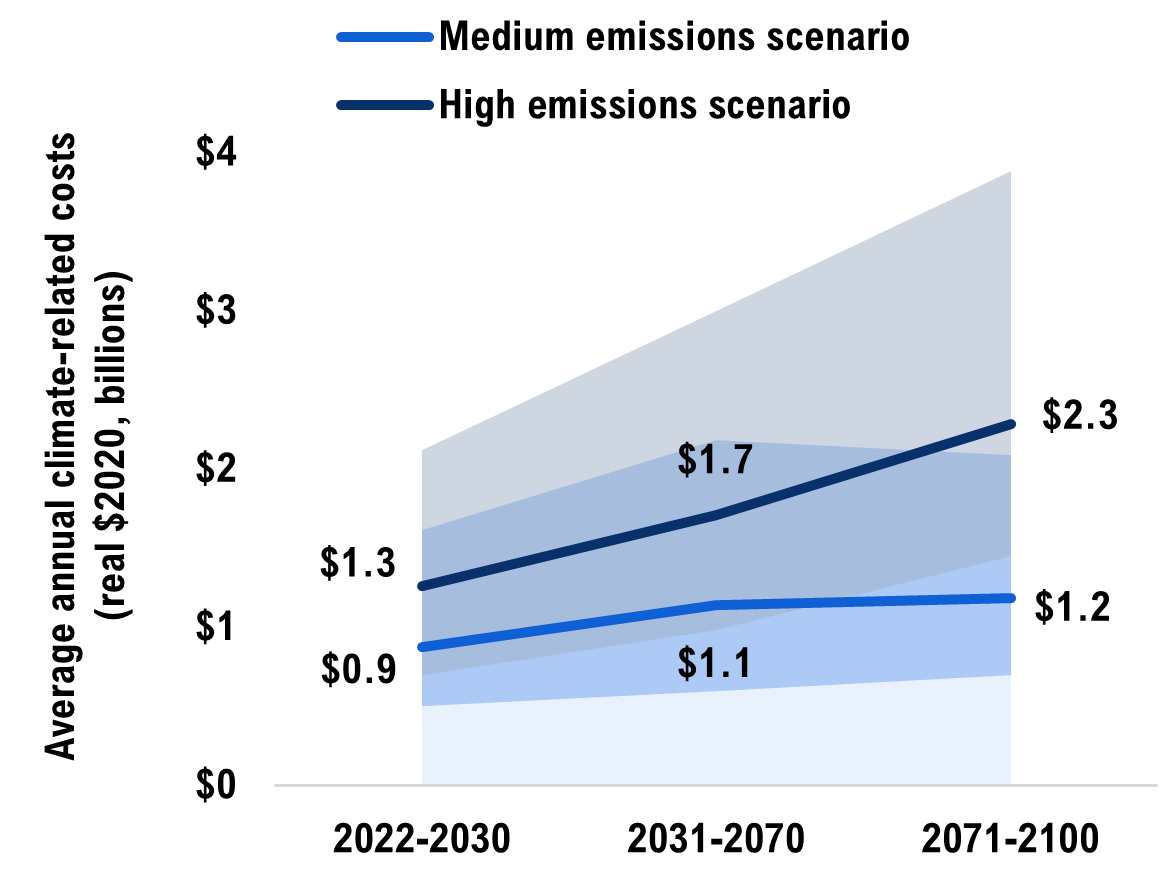
Note: The solid line is the median (or 50th percentile) projection. The coloured bands represent the range of possible outcomes in each emissions scenario.
Source: FAO.
Given the uncertain extent of warming that will occur in each emissions scenario, as well as the engineering uncertainty in costing the array of adaptation options, the full range of climate-related costs is presented in Figure 5-5.
These average annual costs will accumulate over the remainder of this century. The FAO projects that climate-related costs would accumulate to approximately $8 billion by 2030 in the medium emissions scenario (a 34 per cent increase in municipal infrastructure costs relative to the stable climate projection). In the high emissions scenario, these additional costs accumulate to approximately $11 billion by 2030 (a 48 per cent increase, as adapting assets to withstand more extreme rainfall in high emissions scenario is more expensive).[50]
Figure 5-6 Cumulative climate-related costs in the reactive adaptation strategy to 2100
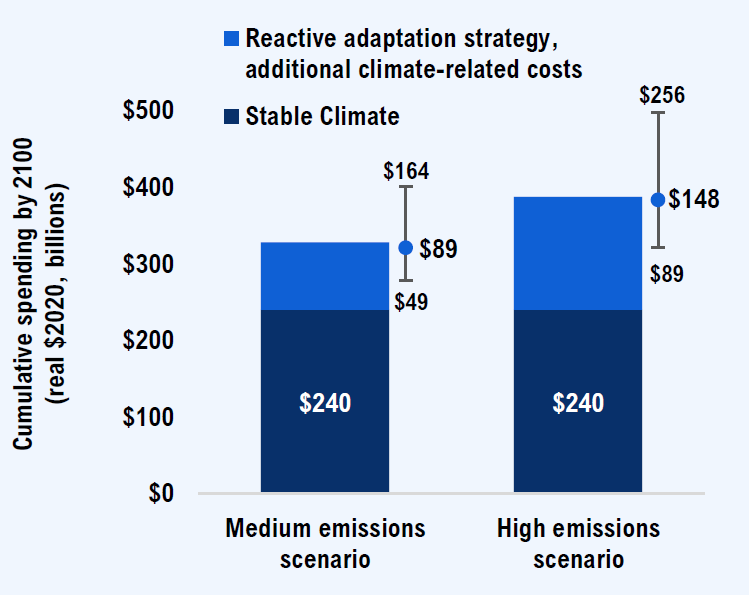
Source: FAO.
Figure 5-6 shows the cumulative infrastructure costs under both emissions scenarios. Maintaining the existing portfolio of public storm and wastewater infrastructure in a state of good repair and expanding its capacity in the reactive adaptation strategy will increase cumulative infrastructure costs by $89 billion over the century in the medium emissions scenario (median projection). This represents a 37 per cent increase in costs over what would have occurred in a stable climate. These cumulative costs could range from $49 billion to $164 billion given the climate and engineering uncertainties.
In the high emissions scenario (median projection), cumulative infrastructure costs would instead increase by $148 billion (a 62 per cent increase), with a range of $89 billion to $256 billion.
Projecting public storm and wastewater infrastructure costs in the proactive adaptation strategy
In the proactive adaptation strategy, storm and wastewater assets are adapted at the first available opportunity. This occurs either during an asset’s next major rehabilitation when it is replaced with a new adapted asset instead of being rehabilitated, or at renewal, whichever comes first. In this approach, 33 per cent of storm and wastewater assets are adapted by 2030 and all assets are adapted by 2070. Under this strategy, flood risk is more rapidly reduced compared to the gradual pace of adaptation in the reactive adaptation strategy.
Figure 5-7 shows the average annual climate-related costs in the proactive adaptation strategy. In the medium emissions scenario (median projection), average annual infrastructure costs would increase by $0.9 billion per year over the century. This represents a 29 per cent increase in costs over what would have occurred in a stable climate. In the high emissions scenario (median projection), average annual infrastructure costs would instead increase by $1.6 billion per year over the century, a 53 per cent increase in costs relative to the stable climate scenario.
In a stable climate, a large share of Ontario’s storm and wastewater system would have been replaced in the late century period. In the proactive adaptation strategy, a significant share of storm and wastewater infrastructure is renewed and adapted well before the end of its service life. This would significantly raise infrastructure costs in the short term and mid-century period relative to the stable climate scenario. This also means that fewer renewals would occur in the late century period compared to the stable climate scenario, lowering infrastructure costs in this period.[51]
Figure 5-7 Proactive adaptation significantly raises infrastructure costs in the short term, and lowers costs over the long term
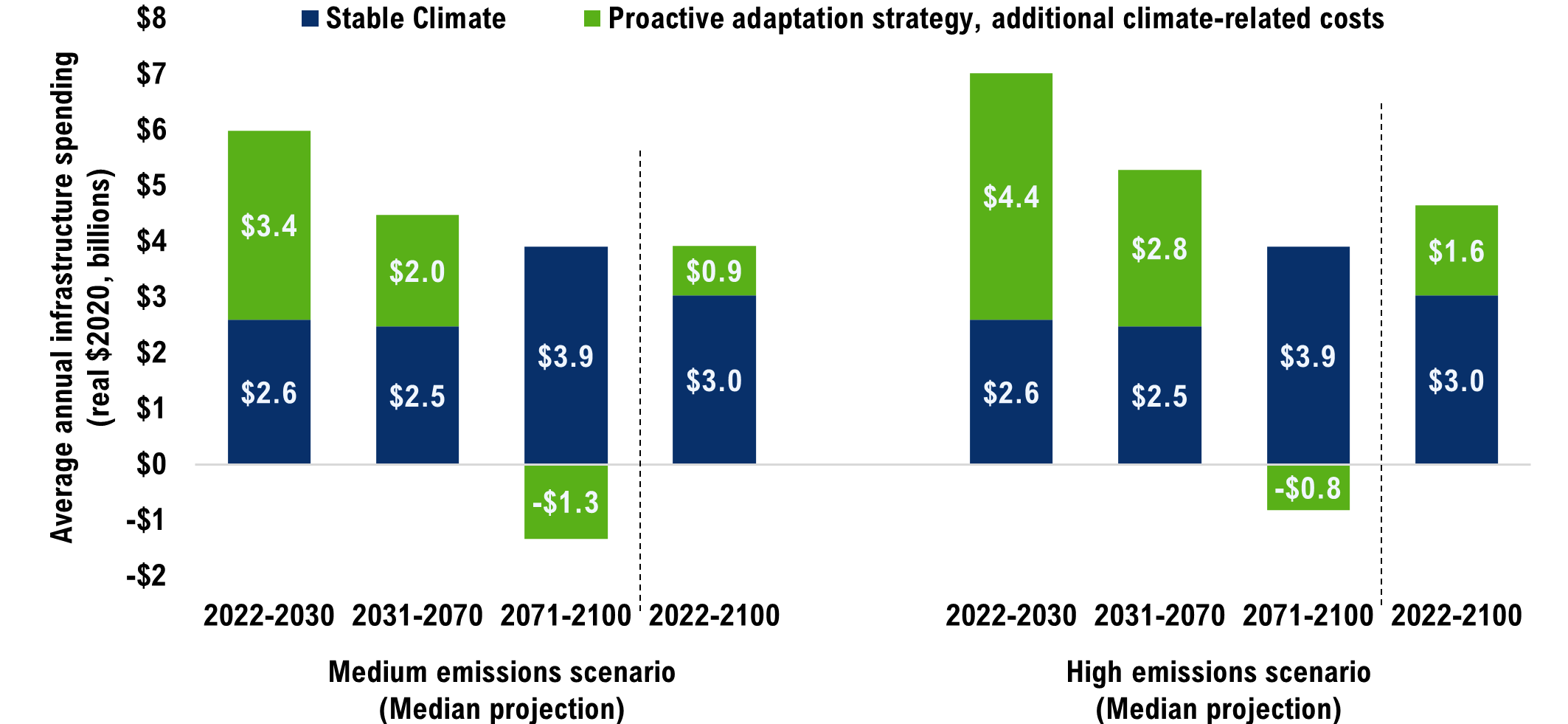
Note: Uncertainty ranges are omitted from this chart for presentation purposes.
Source: FAO.
Figure 5-8 Climate-related costs are subject to climate and engineering uncertainty
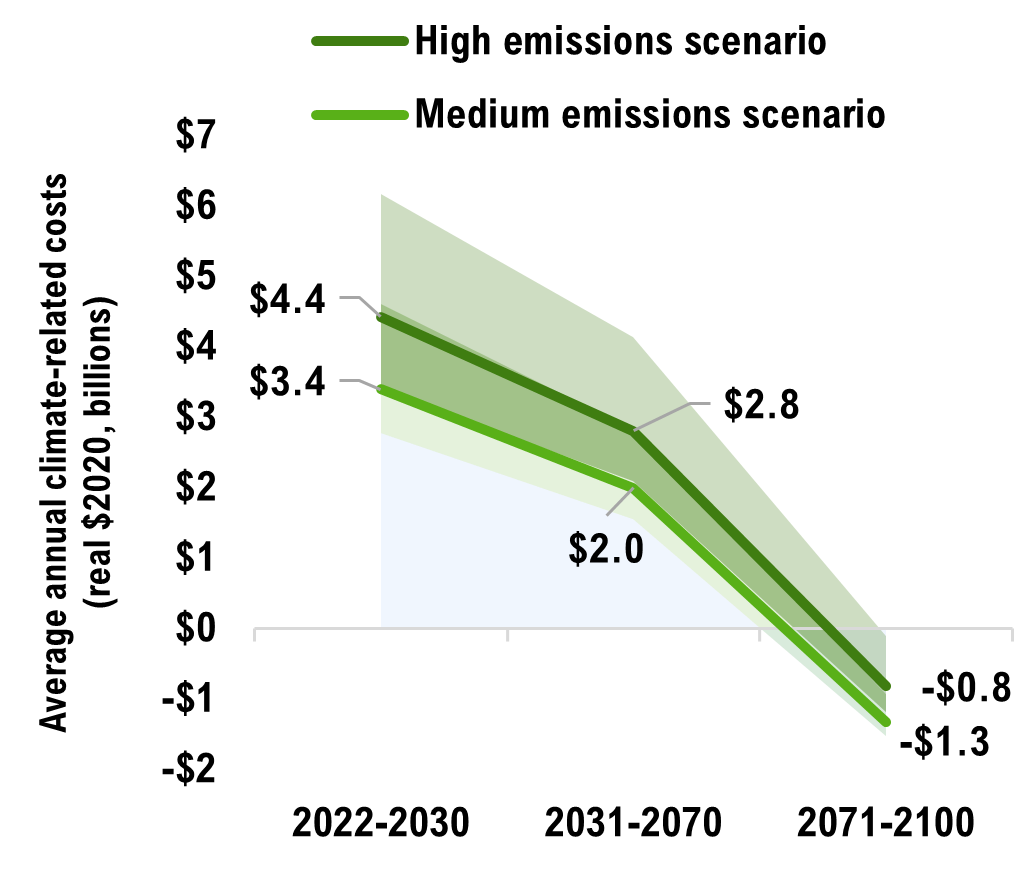
Note: The solid line is the median (or 50th percentile) projection. The coloured bands represent the range of possible outcomes in each emissions scenario.
Source: FAO.
Given the uncertain extent of warming that will occur in each emissions scenario, as well as the engineering uncertainty in costing the array of adaptation options, the full range of annual climate-related costs is presented in Figure 5-8.
These projected annual costs will accumulate over the remainder of this century. The FAO projects that these climate-related costs would accumulate to approximately $31 billion by 2030 in the medium emissions scenario (a 130 per cent increase in municipal infrastructure costs relative to the stable climate projection). In the high emissions scenario, these costs would accumulate to approximately $40 billion by 2030 (a 170 per cent increase, as adapting assets to withstand more extreme rainfall in the high emissions scenario is more expensive).[52]
Figure 5-9 Cumulative climate-related costs in the proactive adaptation strategy to 2100
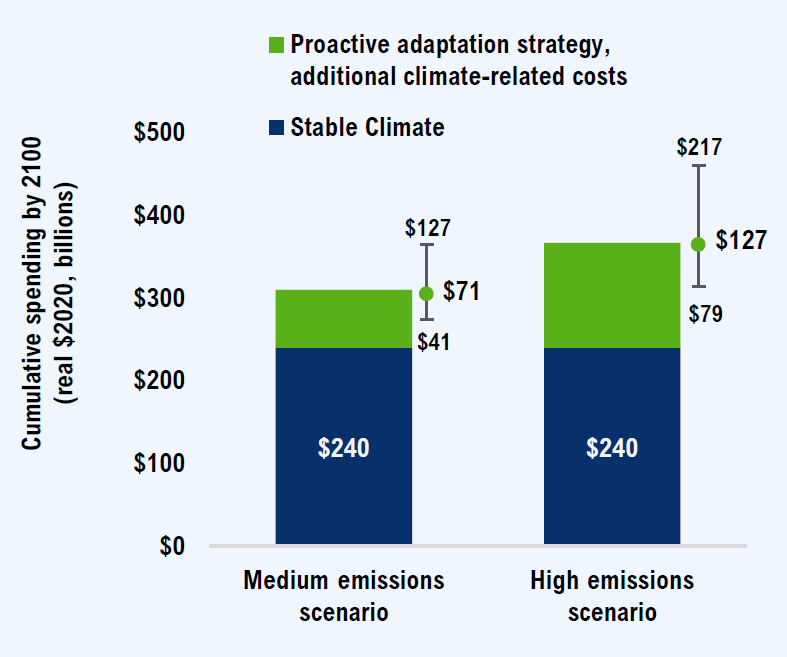
Source: FAO.
Figure 5-9 shows the cumulative infrastructure costs under both emissions scenarios. Over the projection, maintaining the existing portfolio of public storm and wastewater infrastructure in a state of good repair and expanding its capacity in the proactive adaptation strategy will increase cumulative infrastructure costs by $71 billion over the century in the medium emissions scenario (median projection). This represents a 29 per cent increase in costs over what would have occurred in a stable climate. These cumulative costs could range from $41 billion to $127 billion given the climate and engineering uncertainties.
In the high emissions scenario (median projection), the cumulative cost would instead increase by $127 billion (a 53 per cent increase), with a range of $79 billion to $217 billion.
6 | Comparing the costs of different asset management strategies
Chapters 4 and 5 examined the costs of maintaining public linear storm and wastewater infrastructure in a state of good repair in the presence of climate change under three asset management strategies: no adaptation, reactive adaptation and proactive adaptation. These strategies were designed to estimate the scale of the impact that changes in extreme rainfall will impose on municipal infrastructure budgets over the rest of the century.[53]
This chapter first discusses the scope of the costs analyzed across the three asset management strategies. Next, cost estimates across the strategies are compared and the implications of each strategy for reducing flood risks are considered. The chapter then presents the cost profiles of each strategy over the projection. The chapter concludes by discussing the factors that were beyond the scope of the FAO’s analysis but are relevant in determining the most cost-effective strategy for managing specific assets.
The FAO’s analysis focuses on the costs of maintaining municipal linear storm and wastewater infrastructure
This report estimates the impact of increasing extreme rainfall on the costs to municipal governments to keep their linear storm and wastewater infrastructure in a state of good repair, either through maintaining unadapted infrastructure or adapting the assets. The report does not attempt a full cost-benefit analysis and does not estimate the costs that could result from undersized storm and wastewater infrastructure, such as flooding costs borne by households or businesses. These costs were beyond the project’s scope but are likely substantial and relevant to adaptation decisions.
For example, if extreme rainfall inundates an undersized culvert during a storm and the surrounding area floods, this analysis includes the cost of removing the debris that accumulated in the culvert, as well as any repairs required, but does not include the costs to repair the flood damages sustained by households and businesses in the surrounding area. However, the adaptation strategies do include the adaptation costs of installing a new larger culvert, which expands its capacity and reduces flood risk in the surrounding area (see Figure 6-1).
Figure 6-1 The costs of maintaining linear storm and wastewater infrastructure in a changing climate were included, but the impacts of inadequate capacity on households and businesses were not

Source: FAO.
Proactive adaptation will lower flood risks and climate-related costs compared to not adapting
As extreme rainfall becomes more frequent and intense, unadapted assets will increasingly face capacity constraints, heightening flood risk in surrounding areas. Adaptation ensures that storm and wastewater assets will have adequate capacity to manage future projections of extreme rainfall, reducing flood risk. The faster assets are adapted, the faster flood risk is reduced.
Figure 6-2 shows how the share of unadapted public storm and wastewater assets changes over the projection for the three asset management strategies.
The proactive adaptation strategy reduces flood risk faster than the other asset management strategies, as the portfolio of storm and wastewater assets are adapted at a faster pace. In this strategy, the share of unadapted assets quickly declines over the projection, falling to 68 per cent by 2030, to 27 per cent by 2050 and to zero by 2070.[54] While the reactive strategy eventually sees the share of unadapted assets fall to zero, this happens at a much slower pace since the majority of assets remain unadapted for most of the projection. In the no adaptation strategy, flood risk is the largest, as no assets are adapted over the projection.[55]
Figure 6-2 Proactively adapting Ontario’s linear storm and wastewater infrastructure reduces flood risk at the fastest pace

Note: The results presented are based on the average results for the median (or 50th percentile) projection in the medium and high emissions scenarios. The uncertainty bands are omitted from this figure for presentation purpose.
Source: FAO.
Apart from lowering the flood risk to the largest extent, proactively adapting infrastructure is the least costly strategy for municipalities (in real dollars),[56]as highlighted in Figure 6-3. In the no adaptation strategy, no assets are adapted and thus incur higher climate-related infrastructure costs over the entire projection. Similarly, the gradual pace of adaptation in the reactive approach exposes a large share of assets to higher climate-related infrastructure costs over most of the projection, while also incurring the costs of adaptation. In contrast, the rapid pace of adaptation in the proactive strategy avoids much of the higher climate-related operations and maintenance costs.
When comparing cumulative costs in the three strategies, note that if the costs of flooding borne by households and business were incorporated, cumulative costs in the no adaptation strategy would rise significantly, while those in the proactive adaptation strategy would rise the least.
Regardless of which asset management strategy is pursued, the future path of global climate change will be a key determinant in the extent of additional climate-related infrastructure costs. Costs are lower in the medium emissions scenario than in the high emissions scenario (median projections) across all asset management strategies.
Figure 6-3 Proactively adapting Ontario’s public storm and wastewater infrastructure will cost municipalities less than not adapting over the long term, and lowers flood risk more rapidly
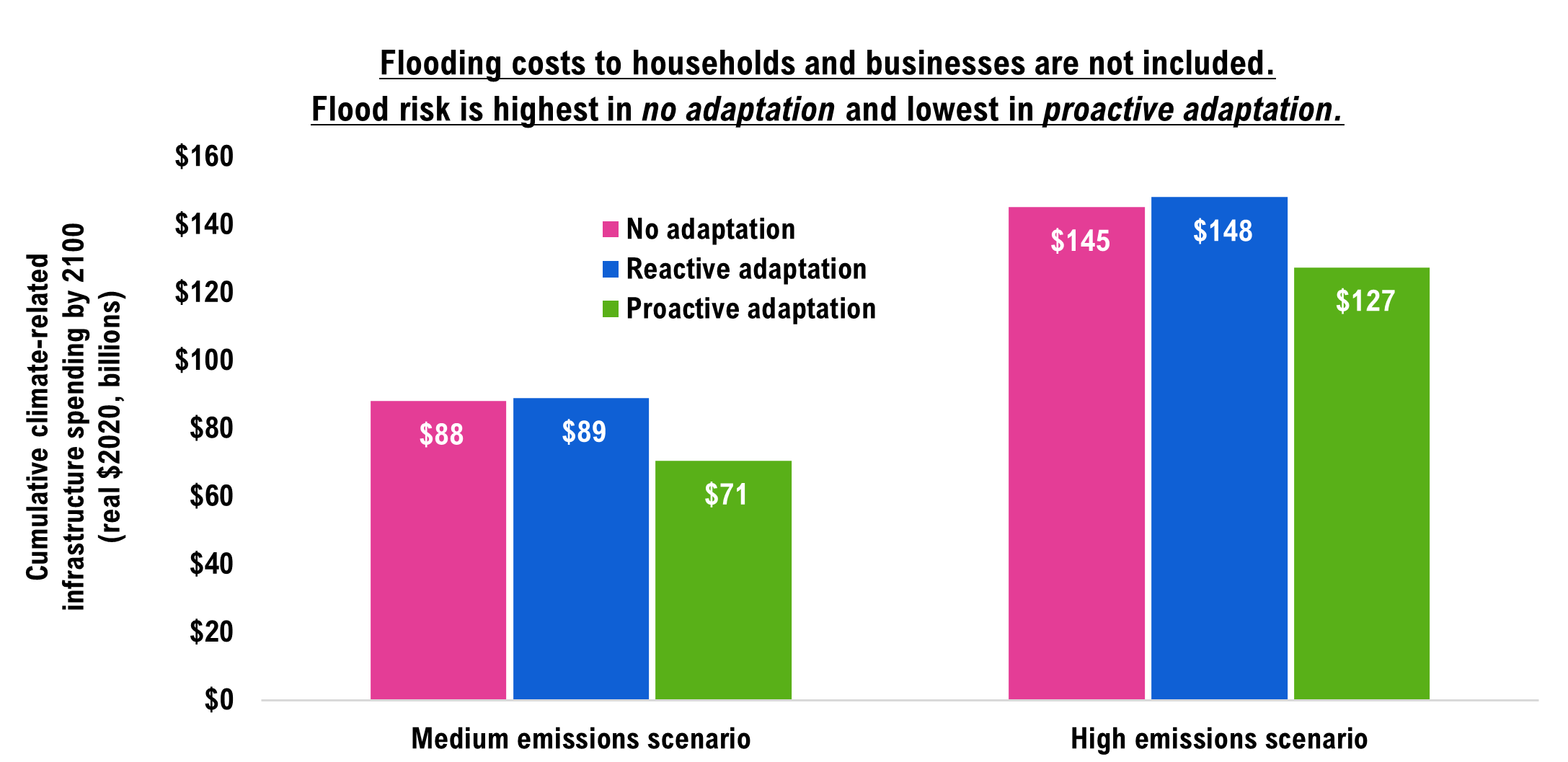
Note: The costs presented are based on the median (or 50th percentile) projection in each emissions scenario. The costs presented in this chart are in addition to the baseline costs over the same period. The uncertainty bands are omitted from this figure for presentation purpose.
Source: FAO.
Proactively adapting linear storm and wastewater infrastructure would require significant upfront costs
Figure 6-4 shows how costs accumulate in the medium and high emissions scenarios under the three asset management strategies.
Figure 6-4 Proactive adaptation has much higher upfront costs
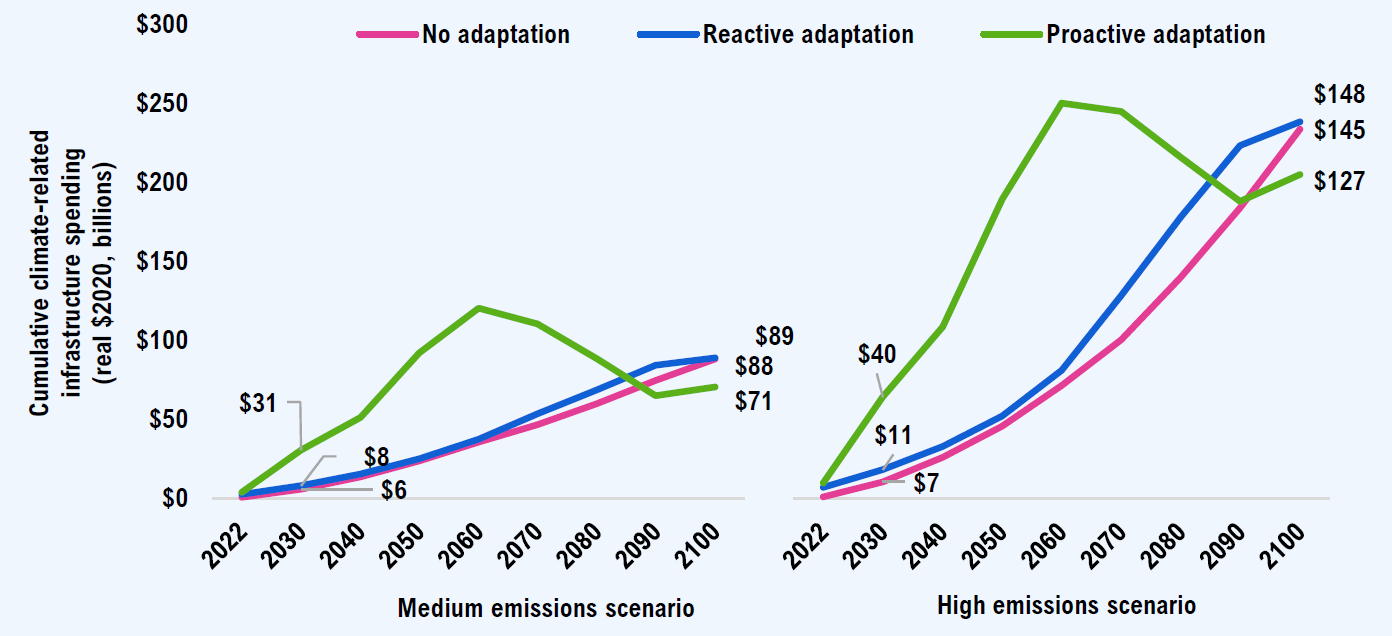
Note: The costs presented are based on the median (or 50th percentile) projection in each emissions scenario. The costs presented in this chart are in addition to the baseline costs over the same period. The uncertainty bands are omitted from this figure for presentation purpose.
Source: FAO.
In the first half of the century, the cost profiles of the no adaptation strategy and the reactive adaptation strategyare similar, as assets in both incur higher costs from more extreme rainfall. In the second half of the century, these two cost profiles start to diverge as the spending necessary to adapt storm and wastewater infrastructure to extreme rainfall raises the cost of the reactive adaptation strategy slightly above the no adaptation strategy.
In contrast, under the proactive adaptation strategy, assets are adapted at a rapid pace largely through early renewals. This strategy sees a substantial accumulation in costs over the next four decades. However, late- century costs decrease as adapted assets avoid higher climate-related operating and capital costs, and fewer future renewals are required.
While the proactive adaptation strategy is the least expensive in real 2020 dollars over the projection, the strategy requires significant upfront costs. By 2030, additional climate-related costs amount to $31 billion in the medium emissions scenario and $40 billion in the high emissions scenario, an average of $3 and $4 billion annually over the nine-year period. This would be a substantial increase in infrastructure spending for municipalities, which have spent an average of $11 billion per year on capital assets across all types of infrastructure (including storm and wastewater assets) over the 2009-2019 period.[57]
Making asset-specific adaptation decisions should consider many other factors
Costing three different asset management strategies at the portfolio level was designed to estimate the scale of the budgetary impact that changes in extreme rainfall could impose over the rest of the century. However, to make asset-specific climate adaptation decisions, many other factors should be considered,[58] including:
- an asset’s individual characteristics (including age, condition and specific climate vulnerabilities);
- a wider array of climate impacts (such as fluvial flooding and permafrost degradation) over the entire useful life of an asset;
- costs to households and businesses, including the costs of flooding and the costs of service disruptions as construction occurs; and
- other non-asset related considerations.[59]
Incorporating these factors would further enhance the FAO’s methodology and would better support adaptation decision-making for individual assets in a changing climate.
7 | Appendices
Appendix A: Scope of storm and wastewater sector assets
| Level of Government | Sector | Total CRV (2020$ billions) |
Description |
|---|---|---|---|
| Municipal | Stormwater | $52.8 |
|
| Wastewater | $71.1 |
|
Appendix B : Scope of climate variables used in costing analysis
The Canadian Centre for Climate Services provided the projections of all climate indicators used in the FAO’s costing analysis. Depending on the nature of the hazard’s interaction with specific storm and wastewater infrastructure components, different climate indicators were used. See WSP’s report for a full description and rationale.[60]
| Climate Hazard | Variable | Definition | Low Emissions (RCP2.6) | Medium Emissions (RCP4.5) | High Emissions (RCP8.5) |
|---|---|---|---|---|---|
| Extreme Rainfall | IDF 24-hour 1:2 | Short duration rainfall intensity for a 24-hour 1-in-2-year event | +15 per cent (+10 to 24 per cent) | +25 per cent (+16 to 39 per cent) | +53 per cent (+38 to 78 per cent) |
| IDF 24-hour 1:100 | Short duration rainfall intensity for a 24-hour 1-in-100-year event | +15 per cent (+10 to 24 per cent) | +25 per cent (+16 to 39 per cent) | +53 per cent (+38 to 78 per cent) | |
| Maximum 5-day precipitation | Maximum amount of precipitation within a year received during five consecutive days | +9 per cent (+8 to 12 per cent) | +11 per cent (+9 to 14 per cent) | +19 per cent (+13 to 20 per cent) | |
| Gravity sewer index[62] | 0.5 * per cent change in IDF 24-hour 1-in-2-year event + 0.5 * per cent change in maximum 5-day precipitation | +12 per cent (+9 to 18 per cent) | +18 per cent (+13 to 27 per cent) | +36 per cent (+25 to +49 per cent) |
The full suite of climate data used in the CIPI project is available on the FAO’s website at https://www.fao-on.org/en/cipi.
Appendix C : The impact of extreme rainfall on linear storm and wastewater infrastructure
This appendix presents the impact of extreme rainfall on the key infrastructure costs for stormwater culverts, stormwater ditches, stormwater pipes, wastewater force mains and wastewater sewer pipes. The appendix presents the total impact of extreme rainfall on operations and maintenance (O&M) spending and useful service life (where applicable) in the absence of adaptation, as well as the costs of adapting this infrastructure to prevent these climate-related impacts.
To establish relationships between relevant climate indicators and key infrastructure costs, the FAO worked with WSP, a large engineering firm with expertise in all aspects of public sector infrastructure, including asset management, public infrastructure construction and operations, and climate change impacts.
At the start of the CIPI project, the FAO and WSP established which climate hazards within the project’s scope (extreme heat, extreme rainfall and freeze-thaw cycles) could have the most significant impact on each asset type. As each hazard would interact with each asset type in a different way, it was agreed that WSP would focus attention on the “interactions” that could present the greatest financial impact to asset managers.
WSP then estimated relationships between changing extreme rainfall variables and infrastructure costs by surveying the relevant engineering experts. To account for engineering uncertainty, WSP aggregated its responses and provided optimistic, pessimistic and most-likely cost relationships.[63] This forms the basis on which the FAO estimated the additional costs of climate hazards to linear storm and wastewater infrastructure in Ontario.[64]
While regional climate projections were used to develop the FAO’s infrastructure cost estimates, for simplicity this appendix presents Ontario-average infrastructure cost results by asset type. The results reflect a weighted average climate projection based on the proportion of assets (by CRV) located in each region.[65] The figures below provide three estimates for each infrastructure cost impact in the medium and high emissions scenarios:
- The solid lines represent the most likely infrastructure cost impact for the 50th percentile climate projection.
- The upper limit of the uncertainty bands represents the pessimistic infrastructure cost impact for the 90th percentile climate projection.
- The lower limit of the uncertainty bands represents the optimistic infrastructure cost impacts of the 10th percentile climate projection.
| In Absence of Adaptation | |
| Useful Service Life |
|
|
Operations & Maintenance 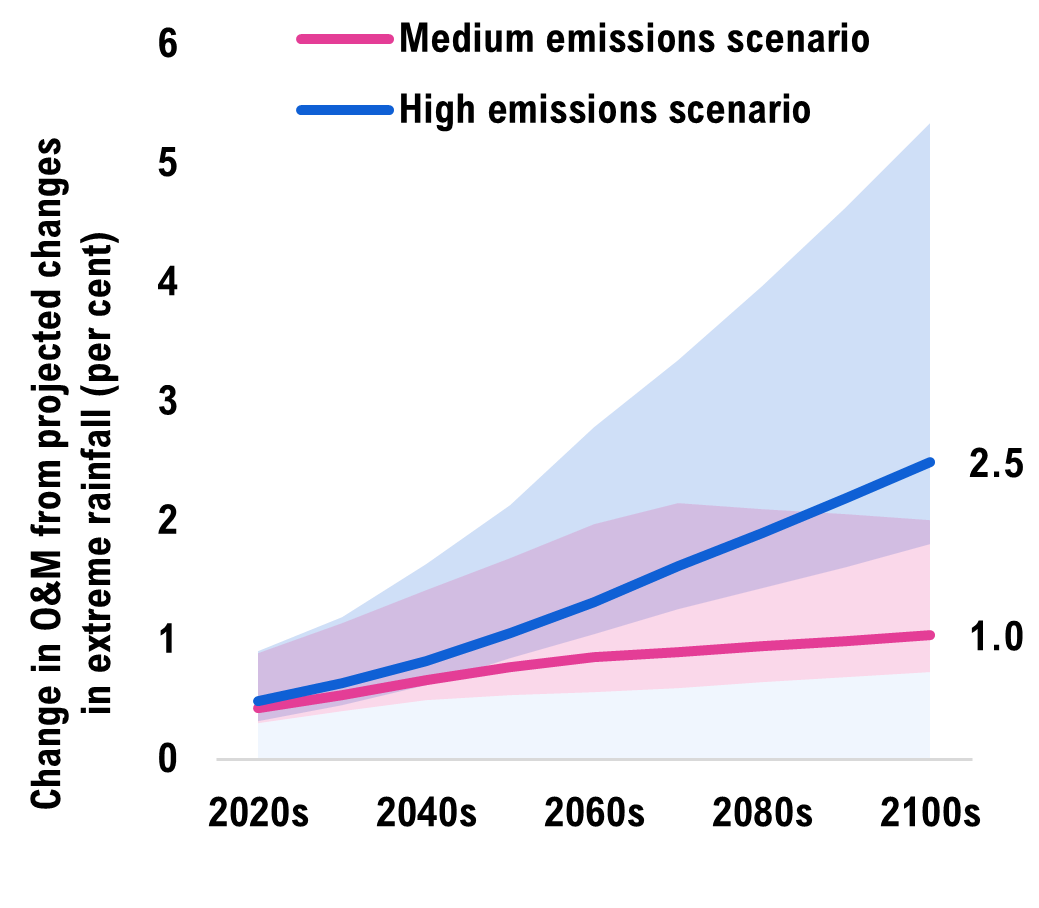
|
|
| Adaptation Costs** | |

|
|
Accessible version
| In absence of adaptation | ||||||||||
|---|---|---|---|---|---|---|---|---|---|---|
| Operation and Maintenance | ||||||||||
| Change in O&M from projected changes in extreme rainfall (per cent) | ||||||||||
| Emissions Scenario | Projection | 2020s | 2030s | 2040s | 2050s | 2060s | 2070s | 2080s | 2090s | 2100s |
| Medium | Low | 0.3 | 0.4 | 0.5 | 0.5 | 0.6 | 0.6 | 0.6 | 0.7 | 0.7 |
| Median | 0.4 | 0.5 | 0.7 | 0.8 | 0.9 | 0.9 | 0.9 | 1.0 | 1.0 | |
| High | 0.9 | 1.1 | 1.4 | 1.7 | 2.0 | 2.1 | 2.1 | 2.1 | 2.0 | |
| High | Low | 0.3 | 0.5 | 0.6 | 0.8 | 1.1 | 1.3 | 1.4 | 1.6 | 1.8 |
| Median | 0.5 | 0.6 | 0.8 | 1.1 | 1.3 | 1.6 | 1.9 | 2.2 | 2.5 | |
| High | 0.9 | 1.2 | 1.6 | 2.1 | 2.8 | 3.3 | 4.0 | 4.6 | 5.3 | |
| Adaptation Costs** | ||||||||||
| Adaptation cost as a share of CRV* (per cent) | ||||||||||
| Emissions Scenario | Projection | 2020s | 2030s | 2040s | 2050s | 2060s | 2070s | 2080s | 2090s | 2100s |
| Medium | Low | 9 | 12 | 15 | 16 | 17 | 18 | 19 | 21 | 22 |
| Median | 14 | 18 | 23 | 26 | 29 | 31 | 32 | 34 | 35 | |
| High | 23 | 29 | 36 | 43 | 51 | 55 | 54 | 53 | 51 | |
| High | Low | 10 | 14 | 19 | 25 | 32 | 38 | 43 | 48 | 54 |
| Median | 17 | 22 | 28 | 36 | 45 | 55 | 65 | 74 | 85 | |
| High | 23 | 31 | 42 | 55 | 71 | 86 | 102 | 119 | 137 | |
| In Absence of Adaptation | |
| Useful Service Life |
|
|
Operations & Maintenance 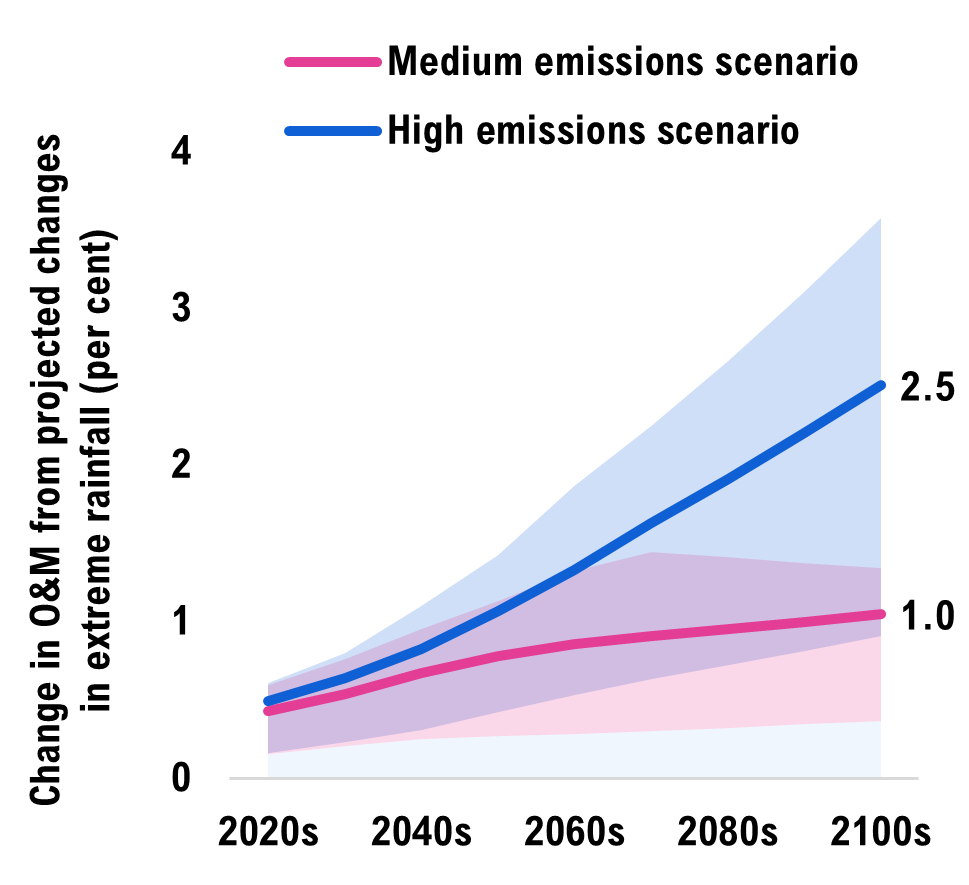
|
|
| Adaptation Costs** | |

|
|
Accessible version
| In absence of adaptation | ||||||||||
|---|---|---|---|---|---|---|---|---|---|---|
| Operation and Maintenance | ||||||||||
| Change in O&M from projected changes in extreme rainfall (per cent) | ||||||||||
| Emissions Scenario | Projection | 2020s | 2030s | 2040s | 2050s | 2060s | 2070s | 2080s | 2090s | 2100s |
| Medium | Low | 0.2 | 0.2 | 0.2 | 0.3 | 0.3 | 0.3 | 0.3 | 0.3 | 0.4 |
| Median | 0.4 | 0.5 | 0.7 | 0.8 | 0.9 | 0.9 | 1.0 | 1.0 | 1.0 | |
| High | 0.6 | 0.8 | 1.0 | 1.1 | 1.3 | 1.4 | 1.4 | 1.4 | 1.3 | |
| High | Low | 0.2 | 0.2 | 0.3 | 0.4 | 0.5 | 0.6 | 0.7 | 0.8 | 0.9 |
| Median | 0.5 | 0.6 | 0.8 | 1.1 | 1.3 | 1.6 | 1.9 | 2.2 | 2.5 | |
| High | 0.6 | 0.8 | 1.1 | 1.4 | 1.9 | 2.2 | 2.7 | 3.1 | 3.6 | |
| Adaptation Costs** | ||||||||||
| Adaptation cost as a share of CRV* (per cent) | ||||||||||
| Emissions Scenario | Projection | 2020s | 2030s | 2040s | 2050s | 2060s | 2070s | 2080s | 2090s | 2100s |
| Medium | Low | 7 | 10 | 12 | 13 | 14 | 14 | 16 | 17 | 18 |
| Median | 13 | 16 | 20 | 23 | 25 | 27 | 28 | 29 | 31 | |
| High | 22 | 29 | 36 | 42 | 50 | 54 | 53 | 52 | 50 | |
| High | Low | 8 | 11 | 15 | 20 | 25 | 30 | 35 | 39 | 43 |
| Median | 15 | 19 | 24 | 31 | 39 | 48 | 56 | 65 | 74 | |
| High | 23 | 30 | 41 | 53 | 70 | 84 | 100 | 116 | 134 | |
| In Absence of Adaptation | |
| Useful Service Life |
|
|
Operations & Maintenance 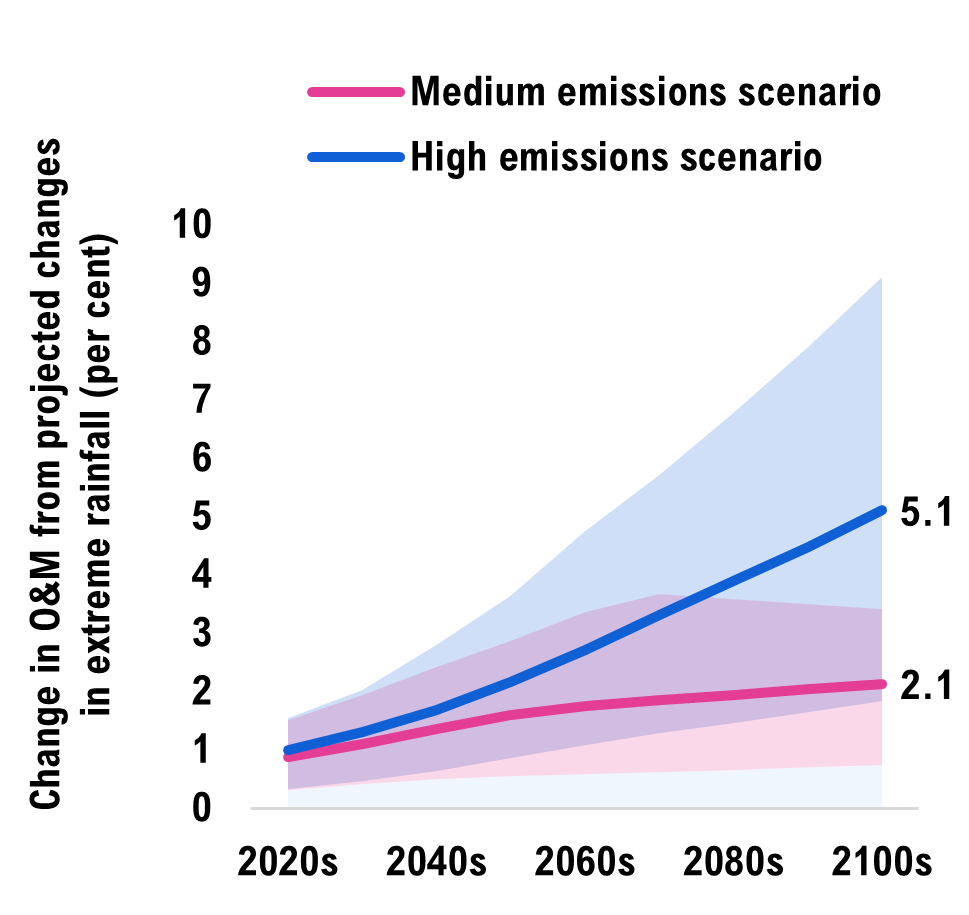
|
|
| Adaptation Costs** | |
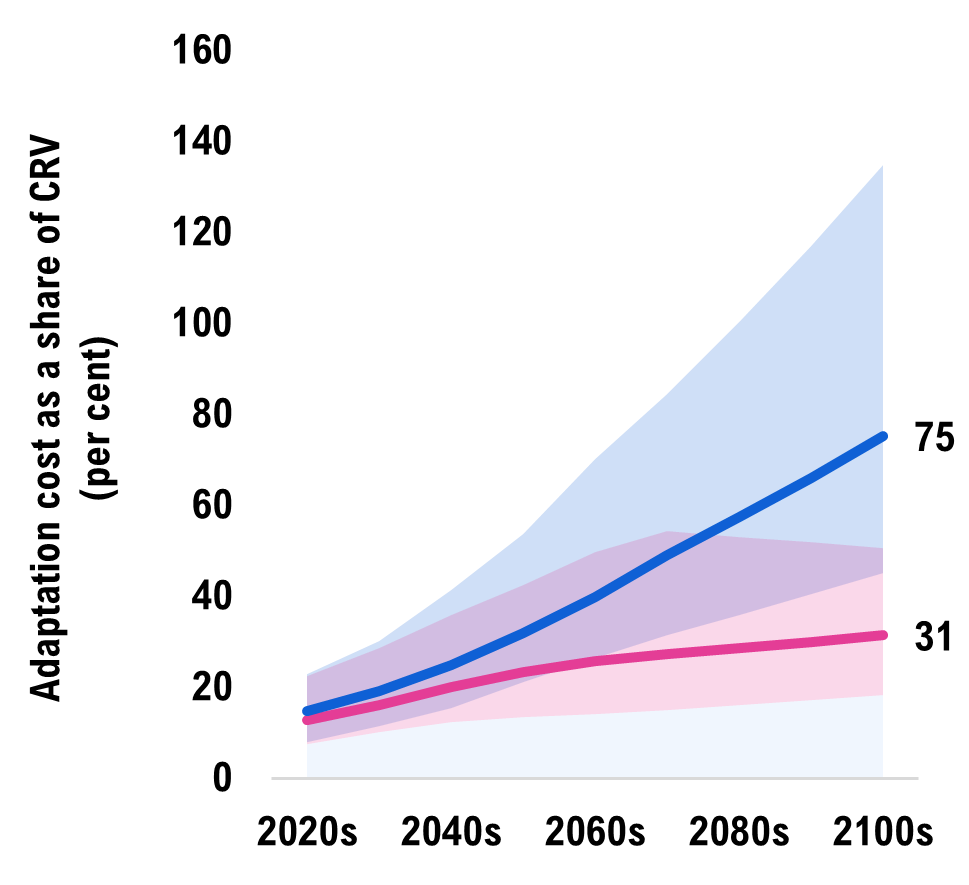
|
|
Accessible version
| In absence of adaptation | ||||||||||
|---|---|---|---|---|---|---|---|---|---|---|
| Operation and Maintenance | ||||||||||
| Change in O&M from projected changes in extreme rainfall (per cent) | ||||||||||
| Emissions Scenario | Projection | 2020s | 2030s | 2040s | 2050s | 2060s | 2070s | 2080s | 2090s | 2100s |
| Medium | Low | 0.3 | 0.4 | 0.5 | 0.5 | 0.6 | 0.6 | 0.7 | 0.7 | 0.7 |
| Median | 0.9 | 1.1 | 1.4 | 1.6 | 1.7 | 1.8 | 1.9 | 2.0 | 2.1 | |
| High | 1.5 | 1.9 | 2.4 | 2.9 | 3.4 | 3.7 | 3.6 | 3.5 | 3.4 | |
| High | Low | 0.3 | 0.5 | 0.6 | 0.9 | 1.1 | 1.3 | 1.5 | 1.7 | 1.8 |
| Median | 1.0 | 1.3 | 1.7 | 2.2 | 2.7 | 3.3 | 3.9 | 4.5 | 5.1 | |
| High | 1.5 | 2.0 | 2.8 | 3.6 | 4.7 | 5.7 | 6.8 | 7.9 | 9.1 | |
| Adaptation Costs** | ||||||||||
| Adaptation cost as a share of CRV* (per cent) | ||||||||||
| Emissions Scenario | Projection | 2020s | 2030s | 2040s | 2050s | 2060s | 2070s | 2080s | 2090s | 2100s |
| Medium | Low | 8 | 10 | 12 | 13 | 14 | 15 | 16 | 17 | 18 |
| Median | 13 | 16 | 20 | 23 | 26 | 27 | 29 | 30 | 31 | |
| High | 22 | 29 | 36 | 42 | 50 | 54 | 53 | 52 | 51 | |
| High | Low | 8 | 11 | 15 | 21 | 26 | 32 | 36 | 40 | 45 |
| Median | 15 | 19 | 25 | 32 | 40 | 49 | 57 | 66 | 75 | |
| High | 23 | 30 | 41 | 54 | 70 | 85 | 100 | 117 | 135 | |
| In Absence of Adaptation | |
|
Useful Service Life 
|
|
|
Operations & Maintenance 
|
|
| Adaptation Costs** | |

|
|
Accessible version
| In absence of adaptation | ||||||||||
|---|---|---|---|---|---|---|---|---|---|---|
| Useful Service Life | ||||||||||
| Change in USL from projected changes in extreme rainfall (per cent) | ||||||||||
| Emissions Scenario | Projection | 2020s | 2030s | 2040s | 2050s | 2060s | 2070s | 2080s | 2090s | 2100s |
| Medium | Low | -1 | -1 | -1 | -2 | -2 | -2 | -2 | -2 | -2 |
| Median | -2 | -3 | -4 | -4 | -5 | -5 | -5 | -5 | -6 | |
| High | -5 | -6 | -8 | -10 | -11 | -12 | -12 | -12 | -11 | |
| High | Low | -1 | -1 | -2 | -3 | -3 | -4 | -4 | -5 | -5 |
| Median | -3 | -4 | -5 | -6 | -7 | -9 | -10 | -12 | -14 | |
| High | -5 | -7 | -9 | -12 | -16 | -19 | -23 | -26 | -30 | |
| Operations and Maintenance | ||||||||||
| Change in O&M from projected changes in extreme rainfall (per cent) | ||||||||||
| Medium | Low | 0.2 | 0.2 | 0.2 | 0.3 | 0.3 | 0.3 | 0.3 | 0.3 | 0.4 |
| Median | 0.4 | 0.5 | 0.7 | 0.8 | 0.9 | 0.9 | 1.0 | 1.0 | 1.0 | |
| High | 0.9 | 1.1 | 1.4 | 1.7 | 2.0 | 2.2 | 2.1 | 2.1 | 2.0 | |
| High | Low | 0.2 | 0.2 | 0.3 | 0.4 | 0.5 | 0.6 | 0.7 | 0.8 | 0.9 |
| Median | 0.5 | 0.6 | 0.8 | 1.1 | 1.3 | 1.6 | 1.9 | 2.2 | 2.5 | |
| High | 0.9 | 1.2 | 1.6 | 2.1 | 2.8 | 3.4 | 4.0 | 4.7 | 5.4 | |
| Adaptation Costs** | ||||||||||
| Adaptation cost as a share of CRV* (per cent) | ||||||||||
| Emissions Scenario | Projection | 2020s | 2030s | 2040s | 2050s | 2060s | 2070s | 2080s | 2090s | 2100s |
| Medium | Low | 6 | 8 | 10 | 10 | 11 | 12 | 13 | 13 | 14 |
| Median | 11 | 14 | 17 | 20 | 22 | 24 | 25 | 26 | 27 | |
| High | 20 | 26 | 32 | 38 | 45 | 49 | 48 | 47 | 46 | |
| High | Low | 6 | 9 | 12 | 17 | 21 | 25 | 28 | 32 | 35 |
| Median | 13 | 17 | 21 | 28 | 35 | 42 | 50 | 57 | 65 | |
| High | 21 | 27 | 37 | 48 | 63 | 76 | 90 | 106 | 122 | |
| In Absence of Adaptation | |
| Useful Service Life |
|
|
Operations & Maintenance 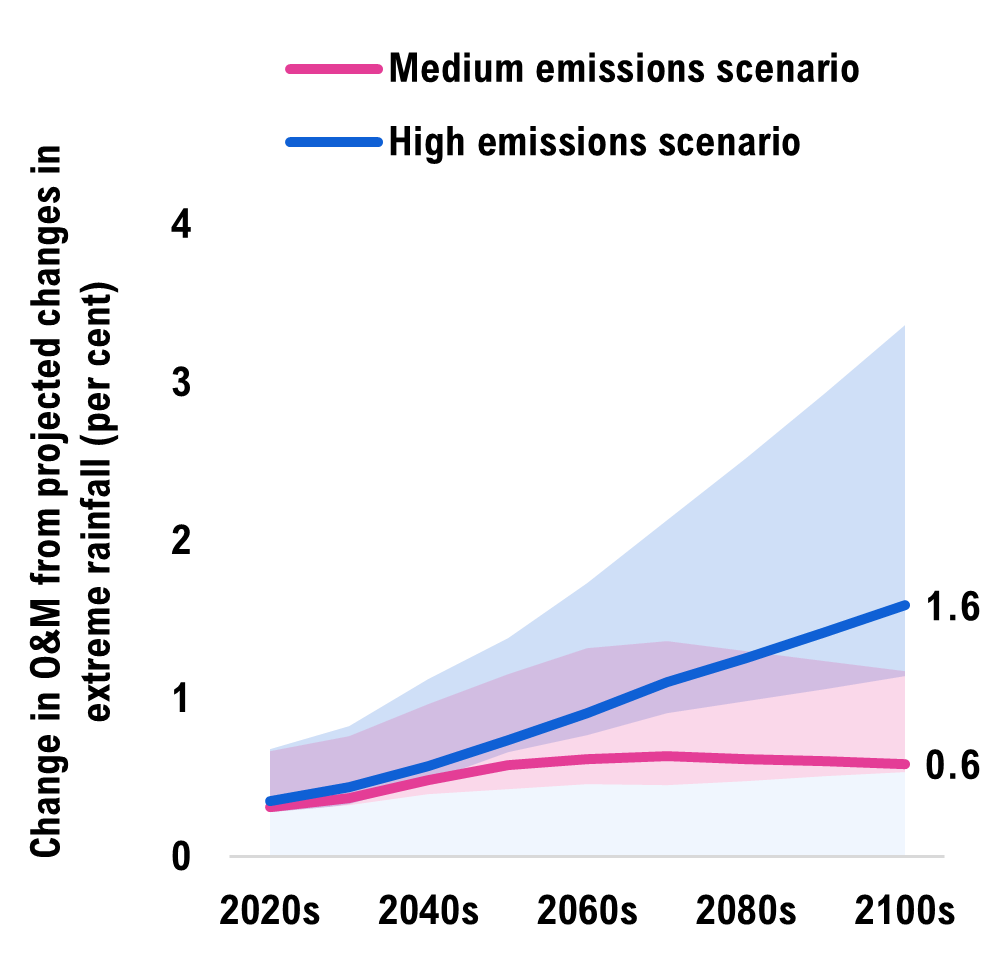
|
|
| Adaptation Costs** | |
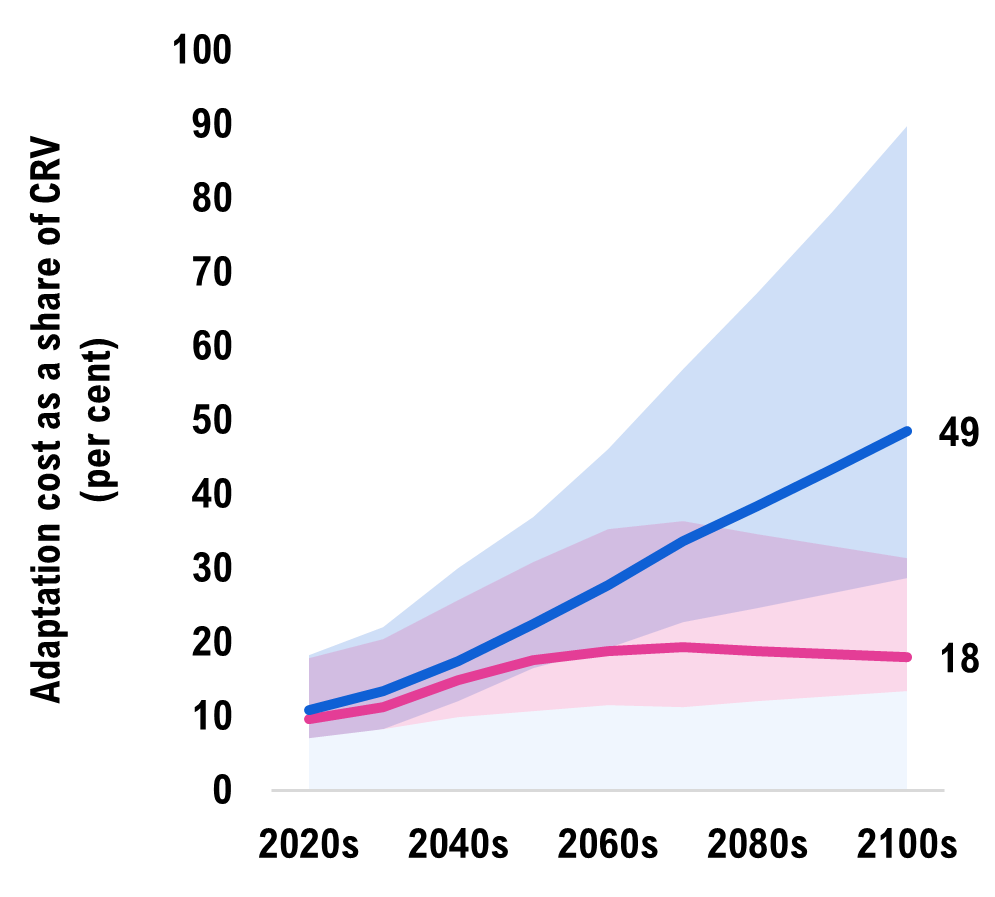
|
|
Accessible version
| In absence of adaptation | ||||||||||
|---|---|---|---|---|---|---|---|---|---|---|
| Operation and Maintenance | ||||||||||
| Change in O&M from projected changes in extreme rainfall (per cent) | ||||||||||
| Emissions Scenario | Projection | 2020s | 2030s | 2040s | 2050s | 2060s | 2070s | 2080s | 2090s | 2100s |
| Medium | Low | 0.3 | 0.3 | 0.4 | 0.4 | 0.5 | 0.5 | 0.5 | 0.5 | 0.5 |
| Median | 0.3 | 0.4 | 0.5 | 0.6 | 0.6 | 0.6 | 0.6 | 0.6 | 0.6 | |
| High | 0.7 | 0.8 | 1.0 | 1.2 | 1.3 | 1.4 | 1.3 | 1.2 | 1.2 | |
| High | Low | 0.3 | 0.3 | 0.5 | 0.7 | 0.8 | 0.9 | 1.0 | 1.1 | 1.1 |
| Median | 0.4 | 0.4 | 0.6 | 0.7 | 0.9 | 1.1 | 1.3 | 1.4 | 1.6 | |
| High | 0.7 | 0.8 | 1.1 | 1.4 | 1.7 | 2.1 | 2.5 | 2.9 | 3.4 | |
| Adaptation Costs** | ||||||||||
| Adaptation cost as a share of CRV* (per cent | ||||||||||
| Emissions Scenario | Projection | 2020s | 2030s | 2040s | 2050s | 2060s | 2070s | 2080s | 2090s | 2100s |
| Medium | Low | 7 | 8 | 10 | 11 | 12 | 11 | 12 | 13 | 13 |
| Median | 10 | 11 | 15 | 18 | 19 | 19 | 19 | 18 | 18 | |
| High | 18 | 20 | 26 | 31 | 35 | 36 | 35 | 33 | 31 | |
| High | Low | 6 | 8 | 12 | 17 | 19 | 23 | 25 | 27 | 29 |
| Median | 11 | 14 | 18 | 23 | 28 | 34 | 38 | 43 | 49 | |
| High | 18 | 22 | 30 | 37 | 46 | 57 | 67 | 78 | 90 | |
Appendix D : Comparing the present value costs of different asset management strategies
Each asset management strategy has a different cost profile over time (see Chapter 6). The proactive adaptation strategy sees higher costs earlier in the century, while the no adaptation and reactive adaptation strategies see costs rise significantly in the latter part of the century. When evaluating alternative long-term financial decisions where the timing of costs varies, a standard approach is to discount real costs into present value dollars using a real discount rate. When discounted, costs incurred further in the future carry less weight relative to costs incurred sooner.
This appendix presents how the choice of discount rates impacts the present value of the costs of the three asset management strategies presented in the report. The discounted costs only highlight the implications of choosing different discount rates and should not be interpreted as a comprehensive cost-benefit analysis.
Evaluating the financial implications of asset-specific adaptation decisions should consider a wider range of societal costs and asset-specific factors that were beyond the scope of this analysis. The discounted results presented below should be viewed in consideration of the following limitations:
- The adaptation costs include the costs needed to upgrade the capacity of storm and wastewater infrastructure to mitigate the risks of flooding damage. However, the costs of flooding damage to households, businesses and government as well as the broader costs of impaired level of service were excluded from the analysis.
- The comparison only includes the impacts of extreme rainfall and excludes other hazards (such as permafrost degradation).
- The results reflect the median projections for the medium and high emissions projections, but exclude the other possible outcomes as estimated by the climate and engineering uncertainties presented throughout the report.
- While this appendix presents a range of discount rates, the appropriate discount rate for evaluating long-term financial decisions about climate change is subject to significant debate.[66] In a paper surveying over 200 experts, recommended discount rates ranged from zero to 10 per cent, with a median value of 2.3 per cent. Despite the wide range of recommended rates, over 90 per cent of respondents indicated they were comfortable with a rate between one and three per cent.[67]
Figure D-1 shows how the choice of a discount rate impacts the present value of the total cost estimates for the median climate projections.
Figure D-1 The present value cost of each asset management strategy under different discount rates
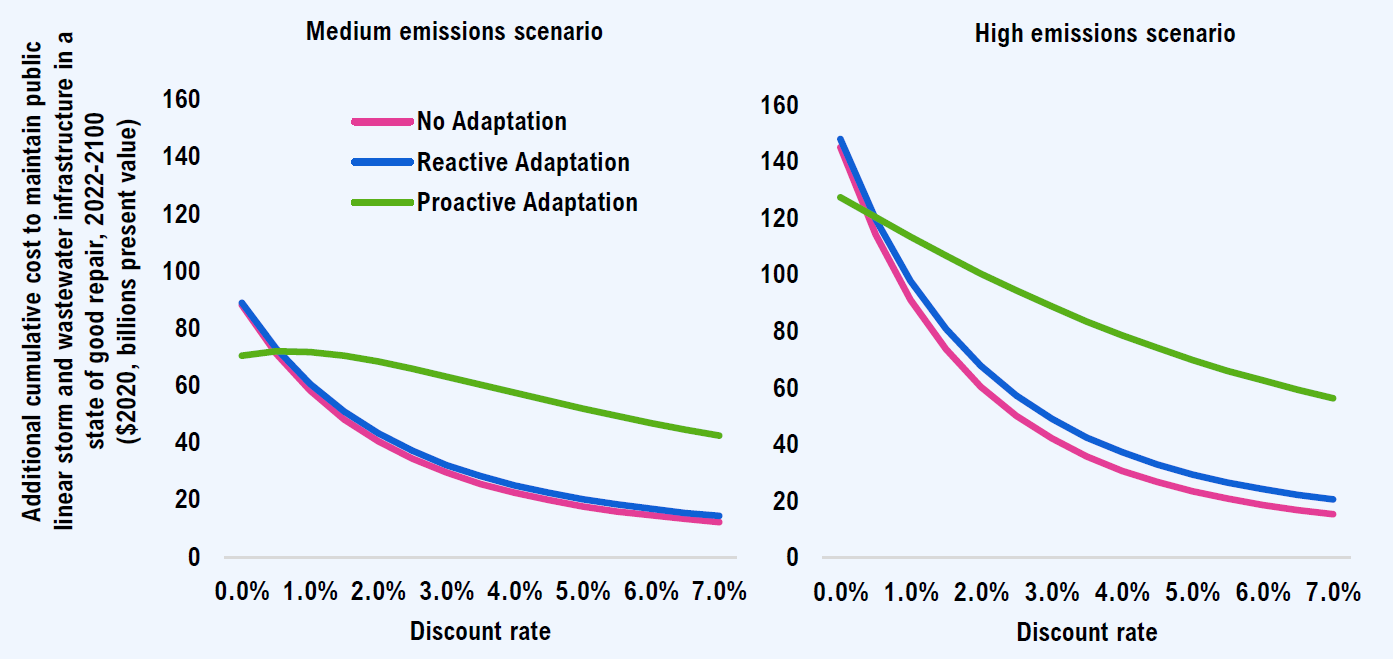
Note: The costs presented use the median (50th percentile) climate projections and “most likely” engineering costs.
Source: FAO.
Appendix E : Costing results in the low emissions scenario
While the report focused on the medium and high emissions scenarios, Appendix E presents the costing results of the three adaptation strategies for all emissions scenarios. The additional climate-related costs in each emissions scenario are presented as cumulative summations over the century.
In the low emissions scenario, a major and immediate turnaround in global climate policies is assumed. Emissions are projected to peak in the early 2020s and decline to zero by the 2080s, limiting the rise in global mean temperatures to 1.6°C (0.8 to 2.4°C) by 2100 compared to the pre-industrial average.[68] Even in the low emissions scenario, changes in extreme rainfall will still have material financial impacts, and would raise the costs of maintaining Ontario’s public storm and wastewater infrastructure assets by $61 billion (26 per cent above baseline) to 2100 in the absence of adaptation (median projection).
Figure E-1 More extreme rainfall will raise the cost of maintaining the current portfolio of public stormwater and wastewater infrastructure by $61 billion in the low emissions scenario in the absence of adaptation

Notes: The solid line is the median (or 50th percentile) projection. The coloured bands represent the range of possible outcomes in each emissions scenario. The costs presented in this chart are in addition to the projected baseline costs over the same period.
Source: WSP and FAO.
Figure E-2 A reactive adaptation strategy, where assets are adapted when renewed at the end of their service life to withstand the impacts of more extreme rainfall, will add $62 billion in infrastructure costs over the century in the low emissions scenario
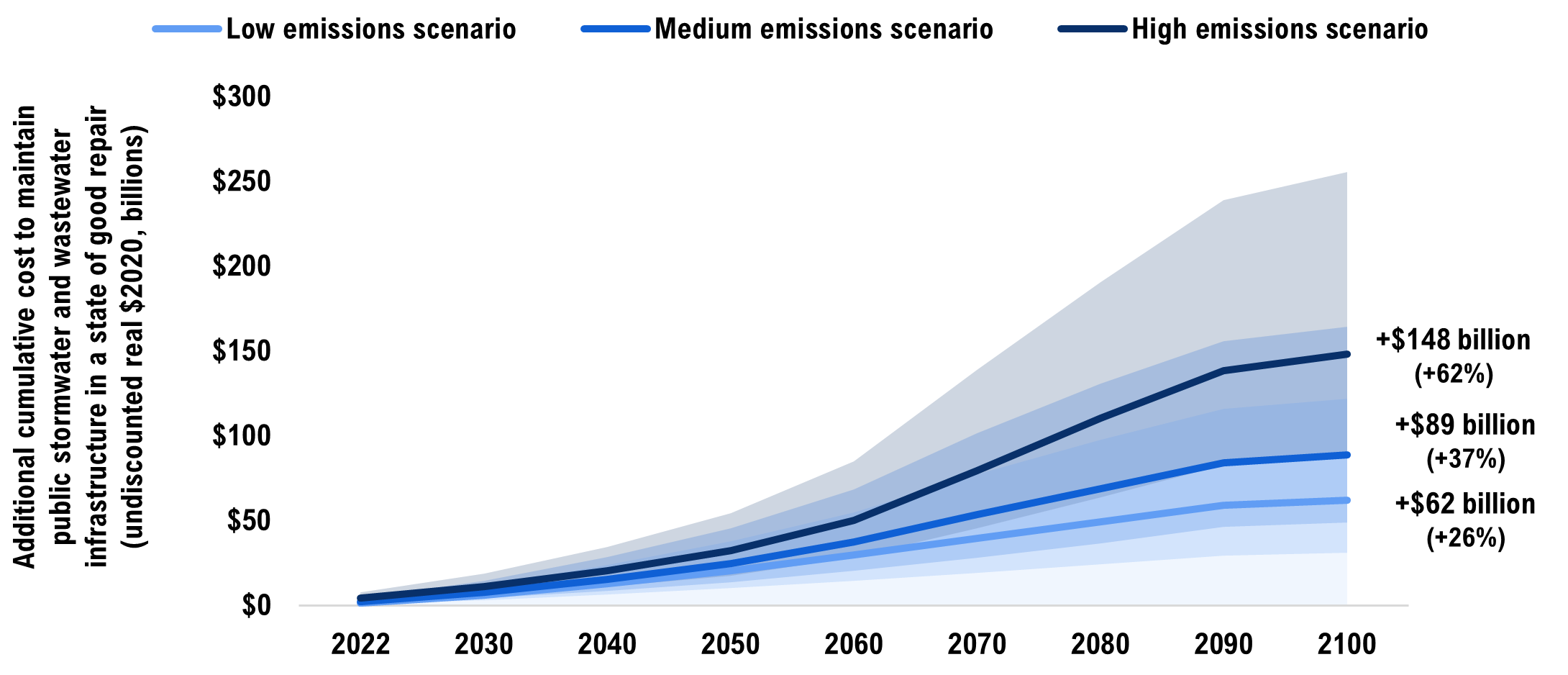
Notes: The solid line is the median (or 50th percentile) projection. The coloured bands represent the range of possible outcomes in each emissions scenario. The costs presented in this chart are in addition to the projected baseline costs over the same period.
Source: WSP and FAO.
Figure E-3 A proactive adaptation strategy, where assets are adapted at the earliest opportunity to withstand the impacts of more extreme rainfall, will add $47 billion in infrastructure costs over the century in the low emissions scenario
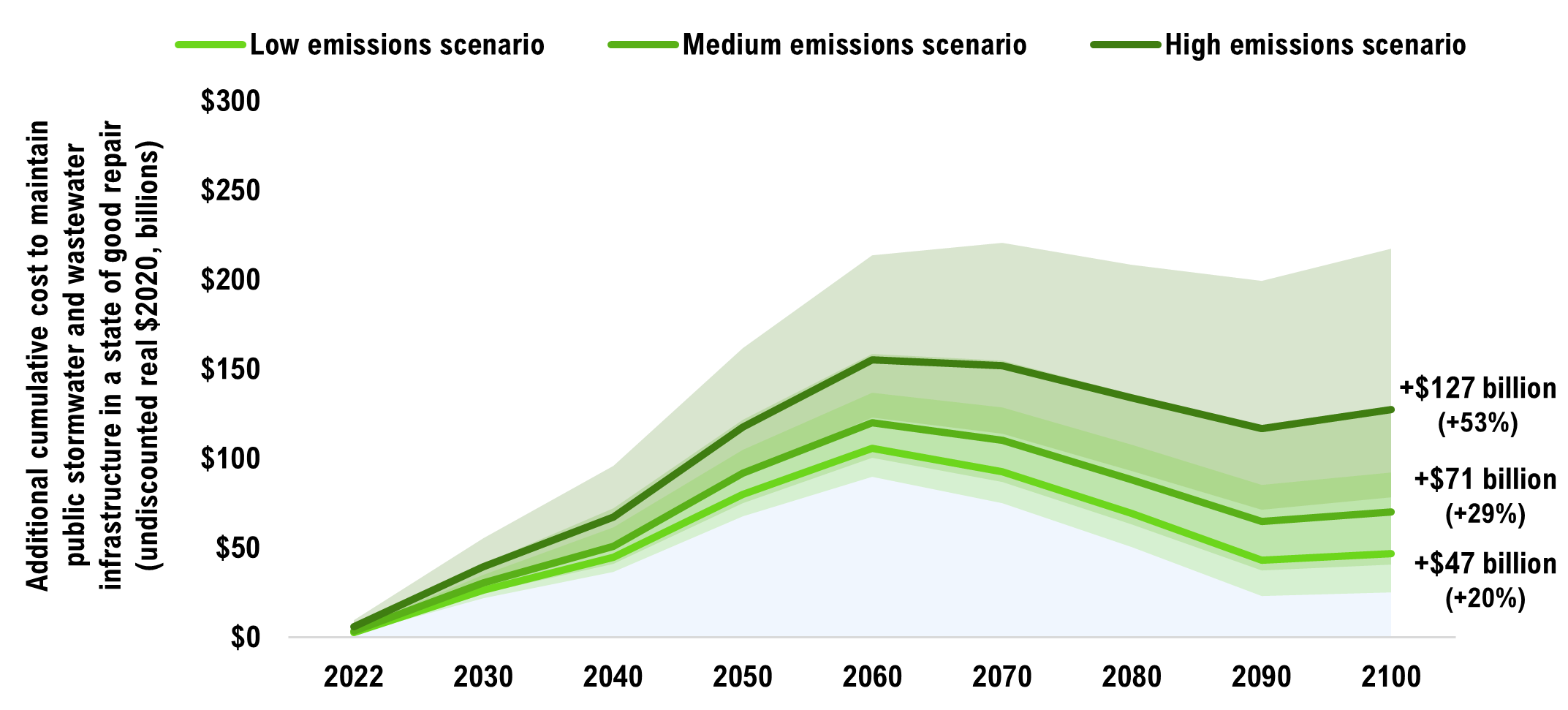
Notes: The solid line is the median (or 50th percentile) projection. The coloured bands represent the range of possible outcomes in each emissions scenario. The costs presented in this chart are in addition to the projected baseline costs over the same period.
Source: WSP and FAO.
Appendix F : Breakdown of cumulative costs under different adaptation strategy by asset categories
| Cumulative Additional Costs (2022-2100) | |||||
|---|---|---|---|---|---|
| Emissions Scenario | Estimate | Base | No Adaptation ($ Billions) |
Reactive Adaptation ($ Billions) |
Proactive Adaptation ($ Billions) |
| Medium | Low | $97 | $21 | $23 | $26 |
| (22%) | (24%) | (27%) | |||
| Median | $57 | $51 | $46 | ||
| (59%) | (53%) | (47%) | |||
| High | $103 | $92 | $77 | ||
| (107%) | (95%) | (80%) | |||
| High | Low | $38 | $43 | $47 | |
| (40%) | (44%) | (49%) | |||
| Median | $95 | $84 | $77 | ||
| (98%) | (86%) | (80%) | |||
| High | $160 | $140 | $126 | ||
| (165%) | (145%) | (130%) | |||
| Cumulative Additional Costs (2022-2100) | |||||
|---|---|---|---|---|---|
| Emissions Scenario | Estimate | Base | No Adaptation ($ Billions) |
Reactive Adaptation ($ Billions) |
Proactive Adaptation ($ Billions) |
| Medium | Low | $143 | $23 | $26 | $15 |
| (16%) | (18%) | (10%) | |||
| Median | $31 | $38 | $25 | ||
| (22%) | (27%) | (17%) | |||
| High | $63 | $72 | $50 | ||
| (44%) | (51%) | (35%) | |||
| High | Low | $39 | $46 | $31 | |
| (27%) | (32%) | (22%) | |||
| Median | $50 | $64 | $50 | ||
| (35%) | (45%) | (35%) | |||
| High | $98 | $115 | $91 | ||
| (68%) | (81%) | (64%) | |||
8 | References
Asset Management BC. (n.d.). Climate Change and Asset Management: A Sustainable Service Delivery Primer. Retrieved from https://www.assetmanagementbc.ca/wp-content/uploads/The-BC-Framework_Primer-on-Climate-Change-and-Asset-Management.pdf
Boyd , R., & Markandya, A. (2021). Cost and Benefits of Climate Change Impacts and Adaptation: National Issues Report. Government of Canada, Ottawa. Retrieved from https://www.nrcan.gc.ca/sites/nrcan/files/GNBC/Chapter%206_Costs%20and%20Benefits%20of%20Climate%20Change%20Impacts%20and%20Adaptation_Final_EN.pdf
Canadian Infrastructure. (2019). Wastewater Collection and Treatment – The Canadian Infrastructure Report Card. Retrieved from http://canadianinfrastructure.ca/en/waste-water.html
Canadian Infrastructure. (2019). Stormwater Management – The Canadian Infrastructure Report Card. Retrieved from http://canadianinfrastructure.ca/en/storm-water.html
Canadian Institute for Climate Choices. (2022). Under Water: The Costs of Climate Change for Canada’s Infrastructure. Retrieved from https://climatechoices.ca/wp-content/uploads/2021/09/Infrastructure-English-FINAL-jan17-2022.pdf
Cannon, A. J., Jeong, D. I., Zhang, X., & Zwiers, F. W. (2020). Climate-Resilient Buildings and Core Public Infrastructure: An Assessment of the Impact of Climate Change on Climatic Design Data in Canada. Government of Canada, Environment and Climate Change Canada, Gatineau. Retrieved from https://publications.gc.ca/collections/collection_2021/eccc/En4-415-2020-eng.pdf
City of London. (2019). Corporate Asset Management Plan. London. Retrieved from https://london.ca/sites/default/files/2020-10/AMP%20-%20Interactive%20Format-%20all%20sections_2019-08-27_AODAv4.2%20%281%29.pdf
City of Toronto. (2009). Design Criteria for Sewers and Watermains. Toronto. Retrieved from https://www.toronto.ca/wp-content/uploads/2017/11/9753-ecs-specs-dcm-Toronto_Sewer_and_Watermain_Manual_March2014.pdf
City of Toronto. (2014). Staff Report: Impacts from the December 2013 Extreme Winter Strom Event on the City of Toronto. Retrieved from https://www.toronto.ca/legdocs/mmis/2013/ex/bgrd/backgroundfile-61502.pdf
City of Toronto. (2021). Design Criteria for Sewers and Watermains. Toronto. Retrieved from https://www.toronto.ca/wp-content/uploads/2021/01/8d16-ecs-specs-dcm-design-criteria-sewers-watermains-Jan2021.pdf
City of Toronto. (n.d.). Ditches. Retrieved from https://www.toronto.ca/services-payments/streets-parking-transportation/road-maintenance/ditches/#:~:text=Ditches%20are%20linear%2C%20sodded%20excavations,corridors%2C%20residential%20and%20industrial%20areas
City of Toronto. (n.d.). The Sewers on the Street. Retrieved from https://www.toronto.ca/services-payments/water-environment/managing-rain-melted-snow/what-is-stormwater-where-does-it-go/the-sewers-on-the-street/
City of Windsor. (2020). Degrees of Change: Climate Change Adaptation Plan. Retrieved from https://icleicanada.org/wp-content/uploads/2020/03/S-20_2020-Climate-Change-Adaptation-Plan-FINAL-Feb-19-2020.pdf
Drupp, M. A., Freeman, M. C., Groom, B., & Nesje, F. (2015). Discounting Disentangled. University of Leeds and London School of Economics and Political Science, Centre for Climate Change Economics and Policy and the Grantham Research Institute on Climate Change and Environment. Retrieved from https://www.lse.ac.uk/granthaminstitute/wp-content/uploads/2015/06/Working-Paper-172-Drupp-et-al.pdf
Engineers Canada. (2018). Developing a Stormwater Quality Management Standard (QMS) in Light of Climate Change. Toronto. Retrieved from https://www.scc.ca/en/system/files/publications/SCC_RPT_SW-QMS_EN.pdf
Federation of Canadian Municipalities. (2020). Investing in Canada’s Future: The Cost of Climate Adaptation at the Local Level. Retrieved from http://assets.ibc.ca/Documents/Disaster/The-Cost-of-Climate-Adaptation-Report-EN.pdf
Financial Accountability Office of Ontario. (2020). Provincial Infrastructure. Retrieved from /Blog/Publications/provincial-infrastructure-2020
Financial Accountability Office of Ontario. (2021). Costing Climate Change Impacts to Public Infrastructure: Project Backgrounder and Methodology. Toronto. Retrieved from /Blog/Publications/cipi-backgrounder
Financial Accountability Office of Ontario. (2021). Municipal Infrastructure. Toronto. Retrieved from /Blog/Publications/municipal-infrastructure-2021
Financial Accountability Office of Ontario. (2021). Costing Climate Change Impacts to Public Infrastructure: Assessing the financial impacts of extreme rainfall, extreme heat and freeze-thaw cycle on public buildings in Ontario. Toronto. Retrieved from /Blog/Publications/cipi-buildings
Financial Information Return. (n.d.). Provincial Summary. Retrieved October 28, 2022, from https://efis.fma.csc.gov.on.ca/fir/index.php/en/open-data/provincial-summary/
Gaur, A., Gaur, A., Yamazaki, D., & Simonovic, S. P. (2019). Flooding related consequences of climate change on Canadian cities and flow regulation infrastructure. Water, 11(1), 63. Retrieved from https://www.mdpi.com/2073-4441/11/1/63/htm
Globe Staff. (2021). Are B.C.’s flood defences holding? What you need to know about forecasts, road closings and more. The Globe and Mail. Retrieved from https://www.theglobeandmail.com/canada/british-columbia/article-bc-fears-new-floods-as-storms-return-heres-what-you-need-to-know-about/#transport
Government of Canada. (2021, February 1). Climate Change and Public Health Factsheets. Retrieved from https://www.canada.ca/en/public-health/services/health-promotion/environmental-public-health-climate-change/climate-change-public-health-factsheets-floods.html
Green Analytics Corp. and Ontario Centre for Climate Impacts and Adaptation Resources. (2015). The Economic Impacts of the Weather Effects of Climate Change on Communities. Retrieved from http://assets.ibc.ca/Documents/Studies/IBC-The-Economic-Impacts.pdf
Hamilton. (2022). Waterworks Asset Management Plan. Hamilton. Retrieved from https://www.hamilton.ca/sites/default/files/2022-09/waterworks-asset-management-plan.pdf
Infrastructure Canada. (2019). Climate Lens. Government of Canada. Retrieved from https://www.infrastructure.gc.ca/pub/other-autre/cl-occ-eng.html#3
Insurance Bureau of Canada. (2018, September 7). Toronto Flood Causes Over $80 Million in Insured Damage. Toronto. Retrieved from http://www.ibc.ca/on/resources/media-centre/media-releases/toronto-flood-causes-over-80-million-in-insured-damage
Intergovernmental Panel on Climate Change. (2013). Annex II: Climate System Scenario Tables. In Climate Change 2013: The Physical Science Basis. Retrieved from https://www.ipcc.ch/site/assets/uploads/2017/09/WG1AR5_AnnexII_FINAL.pdf
Intergovernmental Panel on Climate Change. (2014). Climate Change 2014: Synthesis Report. Geneva. Retrieved from https://ar5-syr.ipcc.ch/ipcc/ipcc/resources/pdf/IPCC_SynthesisReport.pdf
Intergovernmental Panel on Climate Change. (2021). Summary for Policymakers. In Climate Change 2021: The Physical Science Basis. Retrieved from https://www.ipcc.ch/report/ar6/wg1/downloads/report/IPCC_AR6_WGI_SPM.pdf
Intergovernmental Panel on Climate Change. (2014). Chapter 17: Economics of Adaptation. In Climate Change 2014: Impacts, Adaptation, and Vulnerability. Retrieved from https://www.ipcc.ch/site/assets/uploads/2018/02/WGIIAR5-Chap17_FINAL.pdf
International Institute of Sustainable Development. (2021). Advancing the Climate Resilience of Canadian Infrastructure: A review of literature to inform the way forward. Retrieved from https://www.iisd.org/system/files/2021-07/climate-resilience-canadian-infrastructure-en.pdf
Lu, D., Tighe, S. L., & Xie, W. C. (2018). Impact of flood hazards on pavement performance. International Journal of Pavement Engineering. Retrieved from https://www.researchgate.net/profile/Donghui_Lu/publication/327144278_Impact_of_flood_hazards_on_pavement_performance/links/5b9fb74592851ca9ed11a06c/Impact-of-flood-hazards-on-pavement-performance.pdf
Nicholson, M. (2021). Hundreds of thousands of farm animals die in B.C. floods: The agricultural region of Sumas Prairie, near Vancouver, is one of the hardest hit flood zones. Financial Post. Retrieved from https://financialpost.com/commodities/agriculture/farm-animals-died-by-the-hundreds-of-thousands-in-canada-floods
Office of the Parliamentary Budget Officer. (2016). Estimate of the Average Annual Cost for Disaster Financial Assistance Arrangements due to Weather Events. Ottawa. Retrieved from https://qsarchive-archiveqs.pbo-dpb.ca/web/default/files/Documents/Reports/2016/DFAA/DFAA_EN.pdf
Organization for Economic Cooperation and Development (OECD). (2018). Climate-resilient Infrastructure. Retrieved from https://www.oecd.org/environment/cc/policy-perspectives-climate-resilient-infrastructure.pdf
Pacific Climate Impacts Consortium. (2021). PCIC Science Brief: Should the RCP 8.5 emissions scenario represent “business as usual?”. Victoria. Retrieved from https://www.pacificclimate.org/sites/default/files/publications/Science_Brief_39-June_2021-final.pdf
Region of Peel. (2022). Enterprise Asset Management Plan. Retrieved from https://www.peelregion.ca/finance/_media/2021-enterprise-asset-management-plan.pdf
Region of Peel. (n.d.). Sewer Systems. Retrieved from https://www.peelregion.ca/water/your-home/sewer-systems.asp
Township of Muskoka Lakes. (2019). Drainage Maintenance. Retrieved from https://www.muskokalakes.ca/en/residents/drainage-maintenance.aspx#Bridges-Culverts
United Nations Environment Program (UNEP). (2021). Buildings and Climate Change Adaptation: A Call to Action. Retrieved from https://globalabc.org/resources/publications/buildings-and-climate-change-adaptation-call-action
United Nations Framework Convention on Climate Change. (2011). Assessing the Costs and Benefits of Adaptation Options. Retrieved from https://unfccc.int/resource/docs/publications/pub_nwp_costs_benefits_adaptation.pdf
Warren, F. J., & Lemmen, D. S. (2014). Canada in a Changing Climate: Sector Perspectives on Impacts and Adaptation. Government of Canada, Natural Resources Canada, Ottawa. Retrieved from https://www.nrcan.gc.ca/sites/www.nrcan.gc.ca/files/earthsciences/pdf/assess/2014/pdf/Full-Report_Eng.pdf
Warren, F., & Lulham, N. (2021). Canada in a Changing Climate: National Issues. Government of Canada, Ottawa. Retrieved from https://www.nrcan.gc.ca/sites/nrcan/files/pdf/National_Issues_Report_Final_EN.pdf
WSP. (2021). Costing climate change impacts and adaptation for provincial and municipal public infrastructure in Ontario, Deliverable #10 – Final Report. Toronto. Retrieved from /web/default/files/publications/CIPI-wsp/cipi-wsp-report.pdf 
Graphical Descriptions
| Release Date | Report Title |
|---|---|
| Previously Released | Provincial Infrastructure |
| Municipal Infrastructure | |
| CIPI Project Backgrounder and Methodology | |
| WSP Report | |
| Public Buildings and Facilities | |
| Public Transportation Infrastructure | |
| Current Report | Public Linear Storm and Wastewater Infrastructure |
| Upcoming in 2023 | Summary Report |
| Sector | CRV ($ Billions) | Share | |
|---|---|---|---|
| Stormwater | Culverts | $8 | 6% |
| Ditches | $6 | 5% | |
| Pipes | $39 | 31% | |
| Wastewater | Sanitary force mains | $3 | 3% |
| Sewer pipes | $68 | 55% | |
The total value of Ontario’s current portfolio of public linear storm and wastewater infrastructure in 2022 is $124 billion. In a stable climate, the cumulative cost of bringing and maintaining Ontario’s existing suite of public linear stormwater and wastewater infrastructure into a state of good repair until 2100 would be $240 billion, or on average of roughly $3 billion per year. This baseline cost includes $98 billion ($1.2 billion per year) in cumulative O&M expense and $142 billion ($1.8 billion per year) in rehabilitation and renewal expense to 2100.
| Short Term (2022-2030) |
Mid century (2031-2070) |
Late century (2071-2100) |
2022-2100 Average |
|
|---|---|---|---|---|
| Average annual infrastructure spending (real $2020, billions) | $2.6 | $2.5 | $3.9 | $3.0 |
| Ontario IDF 24-hour 1:2 (mm) | Low emissions scenario |
Medium emissions scenario |
High emissions scenario |
||||||
|---|---|---|---|---|---|---|---|---|---|
| Low | Median | High | Low | Median | High | Low | Median | High | |
| 2001-2030 | 51 | 52 | 53 | 51 | 52 | 53 | 51 | 52 | 53 |
| 2011 – 2040 | 52 | 53 | 55 | 52 | 53 | 55 | 52 | 54 | 56 |
| 2021-2050 | 52 | 54 | 56 | 53 | 55 | 58 | 53 | 56 | 58 |
| 2031-2060 | 52 | 55 | 58 | 54 | 56 | 60 | 55 | 59 | 62 |
| 2041-2070 | 53 | 55 | 59 | 55 | 58 | 63 | 58 | 62 | 67 |
| 2051-2080 | 52 | 55 | 60 | 55 | 59 | 65 | 61 | 66 | 73 |
| 2061-2090 | 53 | 55 | 60 | 55 | 60 | 67 | 64 | 70 | 79 |
| 2071-2100 | 53 | 55 | 59 | 56 | 60 | 67 | 66 | 73 | 86 |
| Ontario IDF 24-hour 1:100 (mm) | Low emissions scenario |
Medium emissions scenario |
High emissions scenario |
||||||
| Low | Median | High | Low | Median | High | Low | Median | High | |
| 2001-2030 | 109 | 111 | 114 | 109 | 111 | 113 | 109 | 112 | 113 |
| 2011 – 2040 | 111 | 113 | 118 | 111 | 115 | 119 | 111 | 116 | 121 |
| 2021-2050 | 113 | 115 | 121 | 114 | 118 | 124 | 114 | 121 | 126 |
| 2031-2060 | 112 | 118 | 124 | 116 | 120 | 129 | 119 | 126 | 134 |
| 2041-2070 | 113 | 118 | 128 | 118 | 124 | 135 | 125 | 134 | 144 |
| 2051-2080 | 113 | 119 | 129 | 119 | 126 | 140 | 131 | 142 | 158 |
| 2061-2090 | 114 | 118 | 128 | 119 | 128 | 144 | 137 | 150 | 170 |
| 2071-2100 | 113 | 118 | 127 | 120 | 129 | 144 | 142 | 158 | 184 |
| Ontario maximum 5-day precipitation (mm) | Low emissions scenario |
Medium emissions scenario |
High emissions scenario |
||||||
| Low | Median | High | Low | Median | High | Low | Median | High | |
| 2001-2030 | 54 | 57 | 60 | 55 | 57 | 59 | 54 | 57 | 59 |
| 2011 – 2040 | 55 | 57 | 61 | 56 | 58 | 60 | 55 | 58 | 60 |
| 2021-2050 | 56 | 58 | 62 | 56 | 58 | 61 | 55 | 59 | 62 |
| 2031-2060 | 56 | 59 | 62 | 55 | 59 | 62 | 56 | 60 | 63 |
| 2041-2070 | 57 | 59 | 62 | 56 | 60 | 63 | 57 | 61 | 64 |
| 2051-2080 | 56 | 59 | 62 | 56 | 60 | 64 | 57 | 62 | 65 |
| 2061-2090 | 56 | 58 | 63 | 57 | 61 | 63 | 58 | 63 | 66 |
| 2071-2100 | 56 | 59 | 63 | 57 | 60 | 64 | 59 | 64 | 67 |
| Sector | Examples | |
|---|---|---|
| Stormwater | Culvert | More frequent clearing of debris and sediments resulting from increased water flow. Channel protection will also be subject to accelerated erosion. |
| Ditch | More frequent clearing of debris, shape and slope maintenance, and vegetation pruning to convey increased amounts of stormwater. | |
| Pipe | More frequent and costly inspections and preventive maintenance, as more debris, sediment and vegetation are expected to enter stormwater systems. | |
| Wastewater | Sanitary force main | Higher inflow and infiltration, increasing the volume of wastewater being conveyed to treatment facilities, as well as the pressure required to do so. The increased need for pumping results in greater friction and stress on joints, as well as corrosion, accelerating the deterioration of these assets. |
| Sewer pipe | More frequent inspections, maintenance, and clearing of debris required due to increased inflow and infiltration. Impacts on older and combined sewer systems are likely to be more severe. | |
| Emissions Scenario | Average annual infrastructure spending (real $2020, billions) | 2022-2030 | 2031-2070 | 2071-2100 | 2022-2100 |
|---|---|---|---|---|---|
| Medium (Median projection) | Stable Climate | $2.6 | $2.5 | $3.9 | $3.0 |
| No adaptation strategy, additional climate-related costs | $0.6 | $1.0 | $1.4 | $1.1 | |
| High (Median projection | Stable Climate | $2.6 | $2.5 | $3.9 | $3.0 |
| No adaptation strategy, additional climate-related costs | $0.7 | $1.4 | $2.8 | $1.8 |
| Average annual climate-related costs (real $2020, billions) | ||||
|---|---|---|---|---|
| Emissions Scenario | Projection | 2022-2030 | 2031-2070 | 2071-2100 |
| Medium | Low | $0.4 | $0.5 | $0.7 |
| Median | $0.6 | $1.0 | $1.4 | |
| High | $1.2 | $2.0 | $2.5 | |
| High | Low | $0.4 | $0.8 | $1.5 |
| Median | $0.7 | $1.4 | $2.8 | |
| High | $1.2 | $2.5 | $5.0 | |
| Emissions Scenario | Cost type | Projection | Cumulative spending by 2100 (real $2020, billions) |
|---|---|---|---|
| Medium | Stable Climate | NA | $240 |
| No adaptation strategy, additional climate-related costs | Low | $45 | |
| Median | $88 | ||
| High | $166 | ||
| High | Stable Climate | NA | $240 |
| No adaptation strategy, additional climate-related costs | Low | $78 | |
| Median | $145 | ||
| High | $258 |
The infographic demonstrates how insufficient capacity of public linear storm and wastewater infrastructure can result in flooding and property damage through basement flooding, backups, overflows and water ponding.
| Remaining useful service life | Share of stormwater and wastewater assets by CRV (Per cent) |
|---|---|
| 0-20 years | 1 |
| 20-40 years | 12 |
| 40-60 years | 48 |
| 60-80 years | 39 |
| Sector | Examples | |
|---|---|---|
| Stormwater | Culvert | Upsize using a combination of larger pipes, twinned pipes and/or incorporate source control measures. |
| Ditch | Dig out ditches and reinforce using concrete or geotextiles. | |
| Pipe | Upsize to larger pipes/twinned pipes, and/or incorporate source control measures and green infrastructure solutions to reduce and slow down stormwater. | |
| Wastewater | Sanitary force main | Upsize to larger pipes and increase the capacity of force mains, as inflows from the gravity system could increase loads downstream. |
| Sewer pipe | Upsize to a larger pipe and/or incorporate source control measures such as green infrastructure to help control the infiltration of stormwater flow into gravity sewer. | |
| Proportion of adapted public linear storm and wastewater infrastructure by CRV | ||
|---|---|---|
| Year | Reactive adaptation | Proactive adaptation |
| 2022 | 9 | 10 |
| 2023 | 10 | 12 |
| 2024 | 10 | 13 |
| 2025 | 10 | 14 |
| 2026 | 10 | 16 |
| 2027 | 10 | 21 |
| 2028 | 10 | 29 |
| 2029 | 10 | 32 |
| 2030 | 10 | 33 |
| 2031 | 10 | 34 |
| 2032 | 10 | 35 |
| 2033 | 10 | 35 |
| 2034 | 10 | 36 |
| 2035 | 10 | 39 |
| 2036 | 10 | 40 |
| 2037 | 10 | 41 |
| 2038 | 10 | 44 |
| 2039 | 10 | 45 |
| 2040 | 10 | 47 |
| 2041 | 10 | 54 |
| 2042 | 10 | 60 |
| 2043 | 10 | 65 |
| 2044 | 10 | 69 |
| 2045 | 10 | 70 |
| 2046 | 10 | 72 |
| 2047 | 10 | 72 |
| 2048 | 10 | 72 |
| 2049 | 10 | 72 |
| 2050 | 10 | 73 |
| 2051 | 10 | 73 |
| 2052 | 11 | 73 |
| 2053 | 12 | 87 |
| 2054 | 12 | 91 |
| 2055 | 13 | 91 |
| 2056 | 13 | 92 |
| 2057 | 13 | 92 |
| 2058 | 15 | 93 |
| 2059 | 16 | 93 |
| 2060 | 16 | 93 |
| 2061 | 20 | 93 |
| 2062 | 27 | 93 |
| 2063 | 30 | 93 |
| 2064 | 30 | 93 |
| 2065 | 31 | 93 |
| 2066 | 31 | 93 |
| 2067 | 34 | 95 |
| 2068 | 34 | 95 |
| 2069 | 41 | 99 |
| 2070 | 43 | 100 |
| 2071 | 44 | 100 |
| 2072 | 44 | 100 |
| 2073 | 45 | 100 |
| 2074 | 46 | 100 |
| 2075 | 48 | 100 |
| 2076 | 54 | 100 |
| 2077 | 60 | 100 |
| 2078 | 64 | 100 |
| 2079 | 66 | 100 |
| 2080 | 68 | 100 |
| 2081 | 69 | 100 |
| 2082 | 70 | 100 |
| 2083 | 70 | 100 |
| 2084 | 71 | 100 |
| 2085 | 71 | 100 |
| 2086 | 72 | 100 |
| 2087 | 87 | 100 |
| 2088 | 92 | 100 |
| 2089 | 93 | 100 |
| 2090 | 95 | 100 |
| 2091 | 96 | 100 |
| 2092 | 100 | 100 |
| 2093 | 100 | 100 |
| 2094 | 100 | 100 |
| 2095 | 100 | 100 |
| 2096 | 100 | 100 |
| 2097 | 100 | 100 |
| 2098 | 100 | 100 |
| 2099 | 100 | 100 |
| 2100 | 100 | 100 |
| Emissions Scenario | Average annual infrastructure spending (real $2020, billions) | 2022-2030 | 2031-2070 | 2071-2100 | 2022-2100 |
|---|---|---|---|---|---|
| Medium (Median projection) | Stable Climate | $2.6 | $2.5 | $3.9 | $3.0 |
| No adaptation strategy, additional climate-related costs | $0.9 | $1.1 | $1.2 | $1.1 | |
| High (Median projection) | Stable Climate | $2.6 | $2.5 | $3.9 | $3.0 |
| No adaptation strategy, additional climate-related costs | $1.3 | $1.7 | $2.3 | $1.9 |
| Average annual climate-related costs (real $2020, billions) | ||||
|---|---|---|---|---|
| Emissions Scenario | Projection | 2022-2030 | 2031-2070 | 2071-2100 |
| Medium | Low | $0.5 | $0.6 | $0.7 |
| Median | $0.9 | $1.1 | $1.2 | |
| High | $1.6 | $2.2 | $2.1 | |
| High | Low | $0.7 | $1.0 | $1.4 |
| Median | $1.3 | $1.7 | $2.3 | |
| High | $2.1 | $3.0 | $3.9 | |
| Emissions Scenario | Cost type | Projection | Cumulative spending by 2100 (real $2020, billions) |
|---|---|---|---|
| Medium | Stable Climate | NA | $240 |
| No adaptation strategy, additional climate-related costs | Low | $49 | |
| Median | $89 | ||
| High | $164 | ||
| High | Stable Climate | NA | $240 |
| No adaptation strategy, additional climate-related costs | Low | $89 | |
| Median | $148 | ||
| High | $256 |
| Emissions Scenario | Average annual infrastructure spending (real $2020, billions) | 2022-2030 | 2031-2070 | 2071-2100 | 2022-2100 |
|---|---|---|---|---|---|
| Medium (Median projection) | Stable Climate | $2.6 | $2.5 | $3.9 | $3.0 |
| No adaptation strategy, additional climate-related costs | $3.4 | $2.0 | -$1.3 | $0.9 | |
| High (Median Projection) | Stable Climate | $2.6 | $2.5 | $3.9 | $3.0 |
| No adaptation strategy, additional climate-related costs | $4.4 | $2.8 | -$0.8 | $1.6 |
| Average annual climate-related costs (real $2020, billions) | ||||
|---|---|---|---|---|
| Emissions Scenario | Projection | 2022-2030 | 2031-2070 | 2071-2100 |
| Medium | Low | $2.8 | $1.6 | -$1.5 |
| Median | $3.4 | $2.0 | -$1.3 | |
| High | $4.6 | $2.8 | -$0.9 | |
| High | Low | $3.4 | $2.1 | -$1.2 |
| Median | $4.4 | $2.8 | -$0.8 | |
| High | $6.2 | $4.1 | -$0.1 | |
| Emissions Scenario | Cost type | Projection | Cumulative spending by 2100 (real $2020, billions) |
|---|---|---|---|
| Medium | Stable Climate | NA | $240 |
| No adaptation strategy, additional climate-related costs | Low | $41 | |
| Median | $71 | ||
| High | $127 | ||
| High | Stable Climate | NA | $240 |
| No adaptation strategy, additional climate-related costs | Low | $79 | |
| Median | $127 | ||
| High | $217 |
The FAO's analysis focuses on the cost of maintaining storm and wastewater infrastructure in a changing climate, but inadequate capacity of these assets can have broader societal impacts
This infographic shows how inadequate capacity of storm and wastewater conveyance network will have broader impacts. It shows two examples of the costs (cost to maintain infrastructure and cost to adapt and upgrade capacity of infrastructure to manage extreme rainfall) that were included in the FAO’s analysis. It also shows two examples of the broader costs (flooding costs to households and flooding costs to businesses) that were outside the scope of the FAO’s analysis.
| Share of unadapted assets by CRV (per cent) | |||
|---|---|---|---|
| Year | No adaptation | Proactive adaptation | Reactive adaptation |
| 2022 | 100 | 90 | 91 |
| 2023 | 100 | 88 | 90 |
| 2024 | 100 | 87 | 90 |
| 2025 | 100 | 86 | 90 |
| 2026 | 100 | 84 | 90 |
| 2027 | 100 | 79 | 90 |
| 2028 | 100 | 71 | 90 |
| 2029 | 100 | 68 | 90 |
| 2030 | 100 | 67 | 90 |
| 2031 | 100 | 66 | 90 |
| 2032 | 100 | 65 | 90 |
| 2033 | 100 | 65 | 90 |
| 2034 | 100 | 64 | 90 |
| 2035 | 100 | 61 | 90 |
| 2036 | 100 | 60 | 90 |
| 2037 | 100 | 59 | 90 |
| 2038 | 100 | 56 | 90 |
| 2039 | 100 | 55 | 90 |
| 2040 | 100 | 53 | 90 |
| 2041 | 100 | 46 | 90 |
| 2042 | 100 | 40 | 90 |
| 2043 | 100 | 35 | 90 |
| 2044 | 100 | 31 | 90 |
| 2045 | 100 | 30 | 90 |
| 2046 | 100 | 28 | 90 |
| 2047 | 100 | 28 | 90 |
| 2048 | 100 | 28 | 90 |
| 2049 | 100 | 28 | 90 |
| 2050 | 100 | 27 | 90 |
| 2051 | 100 | 27 | 90 |
| 2052 | 100 | 27 | 89 |
| 2053 | 100 | 13 | 88 |
| 2054 | 100 | 9 | 88 |
| 2055 | 100 | 9 | 87 |
| 2056 | 100 | 8 | 87 |
| 2057 | 100 | 8 | 87 |
| 2058 | 100 | 7 | 85 |
| 2059 | 100 | 7 | 84 |
| 2060 | 100 | 7 | 84 |
| 2061 | 100 | 7 | 80 |
| 2062 | 100 | 7 | 73 |
| 2063 | 100 | 7 | 70 |
| 2064 | 100 | 7 | 70 |
| 2065 | 100 | 7 | 69 |
| 2066 | 100 | 7 | 69 |
| 2067 | 100 | 5 | 66 |
| 2068 | 100 | 5 | 66 |
| 2069 | 100 | 1 | 59 |
| 2070 | 100 | 0 | 57 |
| 2071 | 100 | 0 | 56 |
| 2072 | 100 | 0 | 56 |
| 2073 | 100 | 0 | 55 |
| 2074 | 100 | 0 | 54 |
| 2075 | 100 | 0 | 52 |
| 2076 | 100 | 0 | 46 |
| 2077 | 100 | 0 | 40 |
| 2078 | 100 | 0 | 36 |
| 2079 | 100 | 0 | 34 |
| 2080 | 100 | 0 | 32 |
| 2081 | 100 | 0 | 31 |
| 2082 | 100 | 0 | 30 |
| 2083 | 100 | 0 | 30 |
| 2084 | 100 | 0 | 29 |
| 2085 | 100 | 0 | 29 |
| 2086 | 100 | 0 | 28 |
| 2087 | 100 | 0 | 13 |
| 2088 | 100 | 0 | 8 |
| 2089 | 100 | 0 | 7 |
| 2090 | 100 | 0 | 5 |
| 2091 | 100 | 0 | 4 |
| 2092 | 100 | 0 | 0 |
| 2093 | 100 | 0 | 0 |
| 2094 | 100 | 0 | 0 |
| 2095 | 100 | 0 | 0 |
| 2096 | 100 | 0 | 0 |
| 2097 | 100 | 0 | 0 |
| 2098 | 100 | 0 | 0 |
| 2099 | 100 | 0 | 0 |
| 2100 | 100 | 0 | 0 |
| Cumulative climate-related infrastructure spending by 2100 (real $2020, billions) |
Medium emissions scenario | High emissions scenario |
|---|---|---|
| No adaptation, additional climate-related costs | $88 | $145 |
| Proactive adaptation, additional climate-related costs | $71 | $127 |
| Reactive adaptation, additional climate-related costs | $89 | $148 |
| Cumulative climate-related infrastructure spending (real $2020, billions) |
||||||||||
|---|---|---|---|---|---|---|---|---|---|---|
| Emissions Scenario | Strategy | 2022 | 2030 | 2040 | 2050 | 2060 | 2070 | 2080 | 2090 | 2100 |
| High | Reactive adaptation | $4 | $11 | $21 | $32 | $50 | $80 | $111 | $139 | $148 |
| Proactive adaptation | $6 | $40 | $67 | $118 | $155 | $152 | $134 | $117 | $127 | |
| No adaptation | $1 | $7 | $16 | $29 | $44 | $62 | $87 | $114 | $145 | |
| Medium | Reactive adaptation | $2 | $8 | $15 | $25 | $38 | $54 | $69 | $84 | $89 |
| Proactive adaptation | $4 | $31 | $51 | $92 | $120 | $110 | $88 | $65 | $71 | |
| No adaptation | $1 | $6 | $14 | $24 | $36 | $47 | $60 | $75 | $88 | |
| Additional cumulative cost to maintain public linear storm and wastewater infrastructure in a state of good repair, 2022-2100 ($2020, billions present value) |
||||||
|---|---|---|---|---|---|---|
| Discount rate | Medium Emissions Scenario | High Emissions Scenario | ||||
| No adaptation | Reactive adaptation | Proactive adaptation | No adaptation | Reactive adaptation | Proactive adaptation | |
| 0.0% | 88 | 71 | 89 | 145 | 127 | 148 |
| 0.5% | 71 | 72 | 73 | 114 | 120 | 120 |
| 1.0% | 58 | 72 | 61 | 91 | 114 | 98 |
| 1.5% | 48 | 70 | 51 | 74 | 107 | 81 |
| 2.0% | 41 | 68 | 43 | 60 | 101 | 68 |
| 2.5% | 34 | 66 | 37 | 50 | 94 | 57 |
| 3.0% | 30 | 63 | 32 | 42 | 89 | 49 |
| 3.5% | 26 | 60 | 28 | 36 | 84 | 43 |
| 4.0% | 23 | 57 | 25 | 31 | 79 | 37 |
| 4.5% | 20 | 55 | 22 | 27 | 74 | 33 |
| 5.0% | 18 | 52 | 20 | 24 | 70 | 30 |
| 5.5% | 16 | 49 | 18 | 21 | 66 | 27 |
| 6.0% | 15 | 47 | 17 | 19 | 63 | 24 |
| 6.5% | 13 | 45 | 16 | 17 | 59 | 22 |
| 7.0% | 12 | 43 | 14 | 15 | 56 | 21 |
| Additional cumulative cost to maintain public stormwater and wastewater infrastructure in a state of good repair (undiscounted real $2020, billions) |
||||||||||
|---|---|---|---|---|---|---|---|---|---|---|
| Emissions Scenario | Projection | 2022 | 2030 | 2040 | 2050 | 2060 | 2070 | 2080 | 2090 | 2100 |
| Low | Low | $0 | $3 | $6 | $10 | $14 | $17 | $21 | $25 | $29 |
| Median | $1 | $5 | $12 | $21 | $30 | $36 | $45 | $54 | $61 | |
| High | $1 | $9 | $22 | $37 | $54 | $71 | $89 | $106 | $123 | |
| High | Low | $0 | $3 | $8 | $13 | $19 | $24 | $30 | $38 | $45 |
| Median | $1 | $6 | $14 | $24 | $36 | $47 | $60 | $75 | $88 | |
| High | $1 | $11 | $25 | $44 | $66 | $90 | $117 | $142 | $166 | |
| Medium | Low | $0 | $3 | $8 | $15 | $24 | $34 | $47 | $62 | $78 |
| Median | $1 | $7 | $16 | $29 | $44 | $62 | $87 | $114 | $145 | |
| High | $1 | $11 | $27 | $48 | $75 | $109 | $151 | $201 | $258 | |
| Additional cumulative cost to maintain public stormwater and wastewater infrastructure in a state of good repair (undiscounted real $2020, billions) |
||||||||||
|---|---|---|---|---|---|---|---|---|---|---|
| Emissions Scenario | Projection | 2022 | 2030 | 2040 | 2050 | 2060 | 2070 | 2080 | 2090 | 2100 |
| Low | Low | $1 | $3 | $7 | $10 | $15 | $19 | $24 | $30 | $31 |
| Median | $2 | $6 | $13 | $21 | $30 | $40 | $49 | $59 | $62 | |
| High | $3 | $12 | $24 | $38 | $55 | $77 | $98 | $116 | $122 | |
| High | Low | $1 | $4 | $9 | $14 | $20 | $28 | $37 | $46 | $49 |
| Median | $2 | $8 | $15 | $25 | $38 | $54 | $69 | $84 | $89 | |
| High | $4 | $15 | $28 | $46 | $69 | $102 | $131 | $156 | $164 | |
| Medium | Low | $3 | $6 | $11 | $18 | $29 | $46 | $64 | $83 | $89 |
| Median | $4 | $11 | $21 | $32 | $50 | $80 | $111 | $139 | $148 | |
| High | $8 | $19 | $34 | $55 | $85 | $139 | $191 | $239 | $256 | |
| Additional cumulative cost to maintain public stormwater and wastewater infrastructure in a state of good repair (undiscounted real $2020, billions) |
||||||||||
|---|---|---|---|---|---|---|---|---|---|---|
| Emissions Scenario | Projection | 2022 | 2030 | 2040 | 2050 | 2060 | 2070 | 2080 | 2090 | 2100 |
| Low | Low | $2 | $22 | $37 | $68 | $90 | $75 | $51 | $23 | $25 |
| Median | $3 | $27 | $45 | $80 | $106 | $93 | $69 | $43 | $47 | |
| High | $5 | $35 | $62 | $105 | $137 | $129 | $108 | $86 | $92 | |
| High | Low | $3 | $25 | $41 | $75 | $101 | $87 | $63 | $37 | $41 |
| Median | $4 | $31 | $51 | $92 | $120 | $110 | $88 | $65 | $71 | |
| High | $6 | $41 | $72 | $122 | $159 | $155 | $136 | $117 | $127 | |
| Medium | Low | $4 | $31 | $51 | $92 | $123 | $114 | $93 | $72 | $79 |
| Median | $6 | $40 | $67 | $118 | $155 | $152 | $134 | $117 | $127 | |
| High | $10 | $56 | $96 | $162 | $214 | $221 | $209 | $200 | $217 | |
Footnotes
[1] See Provincial Infrastructure, 2020.
[2] See Municipal Infrastructure, 2021.
[3] See CIPI: Project Backgrounder and Methodology, 2021.
[4] See CIPI: WSP Engineering Report, 2021.
[5] See CIPI: Buildings – Assessing the financial impacts of extreme rainfall, extreme heat and freeze-thaw cycles on public buildings in Ontario, 2021.
[6] See CIPI: Transportation – Assessing the financial impacts of extreme rainfall, extreme heat and freeze-thaw cycles on transportation infrastructure in Ontario, 2022.
[7] For details, see Stormwater and Wastewater in the Canadian Infrastructure Report Card.
[8] The CIPI buildings report included the impact of climate hazards on storm and wastewater building and facilities, such as treatment plants. However, only the impact of climate hazards on the building components (e.g., structure, envelope, etc.) were considered. Any climate-related costs required to expand capacity, such as increasing the size of treatment plants to manage more extreme rainfall or the impact of extreme rainfall on the machinery and equipment used to treat water, were not included. See CIPI: Buildings – Assessing the financial impacts of extreme rainfall, extreme heat and freeze-thaw cycles on public buildings in Ontario, 2021.
[9] The FAO estimates that the current replacement value of linear drinking water infrastructure in Ontario was $69 billion in 2020. See FAO’s Municipal Infrastructure report.
[10] While drinking water infrastructure may experience climate impacts, the FAO was not able to examine all climate impacts to all public infrastructure asset classes. For details on the scope of infrastructure covered in the CIPI project, see CIPI: Project Backgrounder and Methodology, 2021. For detailed information about the assets covered in this report, see Appendix A.
[11] For details on how these assets interact, see Township of Muskoka’s Drainage Maintenance, City of Toronto’s Ditches, and Region of Peel’s Sewer systems.
[12] Current replacement value is the current cost of rebuilding an asset with the equivalent capacity, functionality and performance.
[13] Rehabilitation means repairing part or most of an asset to extend its service life, without adding to its capacity, functionality or performance. Rehabilitation is different from maintenance, which is the routine activities performed on an asset that maximize service life and minimize service disruptions. Assets are rehabilitated to a benchmarked “state of good repair” target and not to a new condition. For more information on the asset management framework used in this report, see CIPI: Project Backgrounder and Methodology, 2021.
[14] Renewal is the replacement of an existing asset, resulting in a new or as-new asset with an equivalent capacity, functionality and performance as the original asset. Renewal is different from rehabilitation, as renewal rebuilds the entire asset.
[15] For details, see Municipal Infrastructure, 2021.
[16] This report only examines the existing suite of linear storm and wastewater infrastructure; it excludes assets that are currently under construction, planned for future construction or necessary to meet future infrastructure demand.
[17] The cost estimates presented throughout this report do not incorporate new technologies or practices that may be used or required of asset managers in the future.
[18] In this report, a “stable climate” means that all climate indicators for extreme rainfall remain unchanged from their 1975-2005 average levels over the projection to 2100.
[19] For more information on the current infrastructure backlog of storm and wastewater assets, see the FAO’s Municipal Infrastructure report.
[20] In addition, the projection does not incorporate future functionality improvements to existing public infrastructure.
[21] The FAO estimates that 87 per cent of the public storm and wastewater assets in scope have a remaining useful service life of 40-80 years. See Figure 5-1 for details.
[22] Several Ontario regulatory agencies mandate the use of storm event statistics as a major criterion for the design of stormwater and wastewater systems. For example, see Design Criteria for Sewers and Watermains, 2009.
[23] See Canada in a Changing Climate: National Issues Report for more information.
[24] Numerous potentially significant climate hazards such as wildfires and fluvial flooding were not included. See CIPI: Project Backgrounder and Methodology, 2021 and CIPI: WSP Engineering Report, 2021 for more information.
[25] See CIPI: WSP Engineering Report, 2021, page 37.
[26] See Climate Change 2013: The Physical Science Basis, Annex II, Table “AII.7.5.” Ranges for the global mean surface temperature represent the 5th percentile to the 95th percentile projections of models used.
[27] The Intergovernmental Panel on Climate Change (IPCC)’s fifth comprehensive assessment (AR5), released in 2013, produced four scenarios called Representative Concentration Pathways (RCPs). The low emissions scenario corresponds to RCP2.6, the medium emissions scenario corresponds to RCP4.5 and the high emissions scenario corresponds to RCP8.5. See the IPCC’s Climate Change 2014: Synthesis Report. The IPCC’s sixth assessment (AR6), released in 2021, contains five updated scenarios called Shared Socioeconomic Pathways (SSPs), which line up with the RCPs from AR5 in terms of average warming. This means that the RCP scenarios from AR5 are still relevant.
[28] See PCIC Science Brief: Should the RCP 8.5 emissions scenario represent “business as usual”? for more information.
[29] For 2-year and 100-year storm events, the per cent changes for each RCP scenario are identical because the same mean temperature projection is used in the Clausius-Clapeyron relation to estimate the projections. See FAO’s CIPI: Project Backgrounder and Methodology for more information.
[30] Scientific confidence in climate projections differs by variable. In general, temperature projections have high scientific confidence due to a large body of evidence on the causes of observed changes and a strong understanding of the climate processes involved. Precipitation projections have medium scientific confidence due to uncertainty associated with a weaker understanding of precipitation-producing processes and how they might be affected by projected climate change. Other climate variables such as wind pressures and snow load have low scientific confidence due to a limited understanding of the climate processes involved. For more information, see Climate-Resilient Buildings and Core Public Infrastructure: An Assessment of the Impact Climate Change on Climatic Design Data in Canada.
[31] This material is drawn from CIPI: WSP Engineering Report, 2021.
[32] The $6.2 billion in cumulative climate-related costs by 2030 is the average of the medium and high emissions scenarios’ median projections. This cost could range from $3 billion to $11 billion given the climate and engineering uncertainties.
[33] Municipalities have many types of metrics for assessing services for storm and wastewater infrastructure, including the proportion of assets in a state of good repair, the share of houses connected to the sewer network, the number of main line backups, the number of sewer odour investigations, the number of combined sewer overflow events, among others. For more examples of level of service requirements for both wastewater and stormwater infrastructure, see the asset management plans of City of Hamilton (pages 131-132), City of London (page 111) and Region of Peel (pages 129-130).
[34] See Design Criteria for Sewers and Watermains, 2021, pages 88 and 100.
[35] See CIPI: WSP Engineering Report, 2021 for more information.
[36] See Canada inundated by severe weather in 2013: Insurance companies pay out record-breaking $3.2 billion to policyholders for more information.
[37] See Toronto Flood Causes over $80 Million in Insured Damage for more information.
[38] See page 7 of the City of Windsor’s Degrees of Change: Climate Change Adaptation Plan for more information.
[39] Other public health impacts can include drowning, hypothermia, or electrocution from damaged wiring. See Climate Change and Public Health Factsheets for more information.
[40] See Infrastructure Canada’s Climate Lens for a general guidance on different factors to consider when making adaptation decisions.
[41] See Developing a Stormwater Quality Management Standard (QMS) in Light of a Changing Climate for more information.
[42] For example, see Asset Management BC’s Climate Change and Asset Management: A Sustainable Service Delivery Primer.
[43] See Canada in a Changing Climate: National Issues for more information.
[44] Ibid.
[45] For examples of municipal planning, see Developing a Stormwater Quality Management Standard (QMS) in Light of a Changing Climate, 2018, Table 2 and Appendix 9.2.
[46] See Canada in a Changing Climate: Sector Perspectives on Impacts and Adaptation for more information.
[47] For example, see Canada in a Changing Climate: National Issues, Box 2.5.
[48] For a full description of adaptation examples, see CIPI: WSP Engineering Report, 2021.
[49] The 2080s are selected to approximate the changes in climate in the latter half of the 21st century. The decadal adaptation costs are presented in Appendix C. However, in practice, assets can be adapted to the projected climate over the service life of individual assets.
[50] These costs could range from $4 billion to $15 billion in the medium emissions scenario and from $6 billion to $19 billion in the high emissions scenario given the climate and engineering uncertainties.
[51] However, these cost savings would be temporary. If assets are replaced before the end of their useful life in this century, it will also bring forward renewals in the 22nd century.
[52] These costs could range from $25 billion to $41 billion in the medium emissions scenario and from $31 billion to $56 billion in the high emissions scenario given the climate and engineering uncertainties.
[53] None of the strategies presented in this report are meant to precisely represent future costs, and portfolio-level costing results are not intended to inform asset-specific management decisions.
[54] Adapting the entire portfolio of storm and wastewater assets does not eliminate flood risk entirely. However, since adaptation ensures that assets can manage the increased volume of rainfall, adapted infrastructure assets are expected to significantly lower the flood risk in surrounding areas compared to unadapted assets.
[55] The magnitude of flood risk of unadapted assets also increases over the projection as extreme rainfall becomes more frequent and intense. For instance, in the high emissions scenario, flood risk will be greater in 2080 than in 2050, since rainfall is expected to become more extreme later in the century.
[56] For a discussion of these cost profiles on a discounted basis, see Appendix D.
[57] Average spending is calculated based on additions and betterments spending across all functional areas of assets managed by Ontario’s municipalities as reported in Financial Information Return (FIR) data from 2009 to 2019.
[58] Several decision-making tools can be used to assist climate change adaptation decisions that capture both financial and economic costs and benefits of adaptation. See Chapter 7: Economics of Adaptation and Assessing the Costs and Benefits of Adaptation Options: An Overview of Approaches for details on different decision tools, Climate-Resilient Infrastructure for a general discussion on costs and benefits of adaptation, and Climate Lens for a general guidance on adaptation decisions.
[59] For example, if a section of road is being replaced (or adapted), this may impact the decision of whether to adapt a section of stormwater pipe. Flooding may also put additional financial burden on governments beyond the cost of maintaining the storm and wastewater infrastructure, as emergency funding needs to be allocated to support flood-affected areas.
[60] See CIPI: WSP Engineering Report, 2021.
[61] For IDF variables, the per cent changes for each RCP scenario are identical because the same mean temperature projection is used in the Clausius-Clapeyron relation to estimate the projections. See CIPI: Project Backgrounder and Methodology, 2021 for more information.
[62] The gravity sewer index captures the impact of extreme rainfall on gravity sewers from higher rainfall intensity (2-year storm events) and increased infiltration (maximum 5-day precipitation). See CIPI: WSP Engineering Report, 2021, page 17.
[63] Some of these cost relationships were subsequently revised to align with the professional judgement of external reviewers.
[64] See CIPI: Project Backgrounder and Methodology, 2021 for more information.
[65] Most of Ontario’s public infrastructure is located in the southern regions. The weighted-average results presented in Appendix C largely reflect the climate projections for those regions.
[66] For more discussion on discounting, see Costs and Benefits of Climate Change Impacts and Adaptation: National Issues Report.
[67] For more information, see Discounting Disentangled.
[68] See Annex II: Climate System Scenario Tables, Table “All.7.5.” Ranges for the global mean surface temperature represent the 5th percentile to the 95th percentile projections of models used.


